

Algarve Trains: The Complete Guide to Trains in the Algarve
The major towns, and many of the smaller towns are served by a small but reliable train network run by the national operator Combois De Portugal. Although the trains are definitely not the most modern looking, or the fastest mode of travel in the Algarve. They do offer a scenic way of travelling sometimes missed in the more modern Algarve. Many of the stations are in the hearts of small towns. It’s a charming prospect of hopping off a train and grabbing a café in an unfamiliar town.
Compared to places like the UK, the trains are a very cheap way of traveling and sightseeing. You just need to be familiar with the routes and timetables. Unhelpfully, you’ll find that most rail maps and even the official ones, don’t list all the stations or show where they are. Luckily for you we’ve created our own!
The Rail Network and Different Algarve Train Lines
Within the Algarve are four different train lines, although they use much of the same railway and train stations. All are operated by the national operator Comboios De Portugal . The four lines of the Algarve train network are Alfa Pendular (AP), Intercidades (IC), Regional (R), and the InterRegional (IR). The most important and most commonly used are the Regional and the Intercidades lines.

The Regional (R) Line in the Algarve
The regional line is the main route from the east to the west Algarve and covers nearly the entirety of the Algarve coastline. Or at least the most populated areas of the Algarve coast. It’s a route that goes from Lagos at its most westerly and in the east right up to the Guadiana river at Vila Real de San Antonio. It is the most cost-effective route, but also the slowest as it stops at every station in the Algarve.
The Regional line is effectively two different lines that originate and terminate in Faro. One heading west, and the other heading east. Usually, but not always, you’ll change train in Faro to continue your journey in either direction. So if you’re heading from Loulé to Tavira on the Regional line, you’ll have a short stop and usually a change of train in Faro. Before continuing east to Tavira.
The Intercidades (IC) Line in the Algarve
The Intercidades line is the main route to and from the Algarve and Lisbon. In Lisbon it departs Lisboa-Oriente, and stops at Entrecampos, and Sete Rios. In the Algarve it stops at Messines-Alte, Tunes, Albufeira, Loulé and Faro. The trains are usually timed to link up with a Regional train heading east or west in the Algarve. If you want to head west, you’ll need to connect in Tunes. If you want to head east, you’ll need to connect to a regional train in Faro.
The Alfa Pendular (AP) Line in the Algarve
The Alfa Pendular is the only trainline that runs up the Atlantic coast stopping at most of the major towns and cities. In general, there are two departures a day from Faro, one early in the morning and one in the Afternoon. It takes approximately 6 hours to reach the final station in Porto at Porto Campanhã. With stops in Aveiro, Coimbra and Lisbon and multiple others along the way. In the other direction there are again usually two departures a day from Porto, one early in the morning and one in the afternoon. Within the Algarve the Alfa Pendular stops at Tunes, Albufeira, Loulé and Faro.
The InterRegional (IR) Line in the Algarve
The InterRegional line is the least common and is essentially a special service that only operates during the summer high season. It follows the same route as the Intercidades between Faro and Lisbon. It’s pretty much a ‘weekend return’ train. That allows people in Lisbon and those arriving to Lisbon, to depart on a Friday evening and arrive in Faro. Then to depart Faro on a Sunday evening and return to Lisbon on the same weekend. It runs from the 7 th June to the 30 th August. It’s a great option for those wanting an Algarve beach break or for those travelling to any of the Algarve’s summer festivals from the Lisbon area!
Price Difference Between the Algarve Train Lines
The biggest thing to consider is that all of the above, depart Faro and stop in Loulé, Albufeira and Tunes. This means when looking at timetables between these places you’ll be presented with a variety of departure times and trains across the different services. In practice the time difference between an AP and an IC train, and an R train departing Faro and arriving in Albufeira is about ten minutes. However, the price difference is more than triple! The regional train costs €3.40, while the IC costs €9.55 and the AP costs €11.70. With a time difference of about 10 minutes, it’s usually worth it to wait for the following Regional train than it is to hop on any of the others!
Train Stations in the Algarve
Below is a map showing all of the train stations in the Algarve and where they are located. The one thing to consider is that several of the stations are relatively far from the towns they serve. If you plan on visiting Loulé, Albufeira, Alcantarilha, Silves or Lagoa, then all these towns will require some additional transport or a long walk.

How to Book Train Tickets in the Algarve
Tickets can be purchased in several different ways. Most commonly for advanced tickets you’ll need to use the official Coimboios de Portugal website . The website is available in both Portuguese and English. Alternatively, for smartphone users you can use the official app available on both Android and IOS . Most of the bigger train stations have official ticket offices, so you can buy them in person during daytime hours.
Unfortunately, many of the smaller stations in the Algarve don’t have ticket offices! If your departure station does not have a ticket office, you can also purchase your ticket on the train at no extra cost. Those with Portuguese bank accounts can also use the Multibanco network to purchase tickets on the Alfa Pendular and Intercidades. Using Multibanco you can buy your ticket from up to 21 days in advance to 15 minutes before departure.
Advanced Ticket Discounts on Trains in the Algarve
Booking tickets in advance usually always gives you a better price, the further in advance, the bigger the discount applying. Although this only applies to Alfa Pendular and Intercidades tickets. If you buy them at least 5 days in advance, you can get up to 50% off. If you buy at least 8 days in advance the discounts can be as big as 65%. Tickets can be purchased up to 60 days in advance so it’s a great way to save on intercity travel. Purchasing tickets well in advance means you can travel between Faro and Lisbon for as little as €11.00. Unfortunately, the advance discounts do not apply to the Regional train line in the Algarve, but the following section does give some good details on how to get discounted tickets on the Regional line that aren’t advanced tickets.
Discounts on Trains in Portugal
There are a wide variety of discounts that people can take advantage of. Senior citizens, those over the age of 65, can travel with 50% off the ticket price. Children younger than 3 can travel for free, if they don’t occupy a seat. Although in practice this rarely gets checked and the trains are not usually full. Children between 4 and 12 can travel for 50% off and have their own seat. If you’re younger than 25 you can travel for 25% off purchase price of the ticket. If you’re between 12-30 then you can also get the 25% youth discount if you have a European Youth Card. In all the above cases, you will need to prove your age, or the age of those travelling with you with an officially recognised ID card. A separate page on the Coimbois website explains the discounts and their terms and conditions fully.
Tourist Travel Card for Trains in the Algarve
The last major discount useful for tourists and visitors to the Algarve is the Tourist Travel Card . It’s a card that allows unlimited travel across the Algarve Regional line, which provides the user unlimited journeys over consecutive days. The tickets cost €20.90 (2 days) and €31.90 (3 days) for adults and €15.90 (2 days) and €23.90 (3 days) for children. It can be a good way of saving money if you’re planning on visiting multiple towns over a few days or a weekend. With common journeys like Faro to Lagos (€7.45 each way), Albufeira to Tavira (€5.90 each way), you should check to see if you’ll actually spend more or less than the tourist card price first though vs. booking in advance or with discounts.

Frequently asked questions about Algarve trains
How to get from faro airport to faro train station (faro airport connection).
If you’re arriving at Faro Airport and planning on taking the train, then you will need to know that Faro Airport is located on the outskirts of Faro. It’s around 7km from the train station to the centre of Faro. To get to the train station, you will need to take a bus, taxi or even an electric scooter from the airport! The local bus service is operated by Proximo , and it’s a short ride on either the no.14 or the no.16 . The bus costs €2.35 for single ticket. If you choose to take a local taxi it will cost approximately €10, or an Uber will cost around €5-6.
Can I bring a bicycle on a train in the Algarve?
Yes, you can bring a bike on board any of the trains on both the Intercidade and Regional lines in the Algarve. The general conditions are that you can only take one bicycle per person, and that person is responsible for lifting and carrying the bike on and off the train. On Regional Trains, officially, you must first check with the on-board inspector who will allow you to bring your bike on if there’s space. If there’s no space, then you will have to wait for the next train. On the Intercidade trains (Faro to Lisbon) there is usually space for 1-2 bikes per carriage. Bicycles can only be taken on the Alfa Pendular network if they’re disassembled and can fit in the normal luggage compartments. For the full regulations check here!
How much luggage can I take on a train?
In general, each person is allowed to take one large bag and one small piece of luggage like a handbag, small backpack or briefcase. That’s the official rules, but rarely are they checked and actually applied. On the train you’ll find an overhead rack, space under the seat and on the entrances to Intercidade and Alfapendular trains large luggage racks for your more typical suitcases.
Do trains run on public holidays in the Algarve?
In Portugal, public holidays are always held on the day that they fall on. Unlike in the UK where normally they’ll be placed on the following Monday. On public holidays, trains will usually run on their published Sunday schedules. This usually results in them operating much more infrequently than normal. Trains and buses do also run on Christmas Day and New Year’s Day.
Disclaimer : The information published here was correct at time of publishing, but for official departure times, rail maps, and ticket booking, you should check Comboios De Portugal website!
Looking for more travel ideas or tips for Portugal? Then join our Facebook community Portugal – Travel, Tips, and Planning !
20 thoughts on “Algarve Trains: The Complete Guide to Trains in the Algarve”
what is the best train route from faro to carviario?
The closest train station to Carvoeiro is Estombar-Lagoa, and you’re better off taking the Regional service from Faro. From there you’ll have to catch a local taxi or bus!
this is SO helpful! thank you for your time and attention to details. Now i feel I can tackle this!… and am looking forward to traversing the Algarve region by train.
Hi there, When did you publish this post? Traveling to the Algarve in a few months and hoping to go without a car so just curious. Thank you!
The post, details and map are regularly updated. The information is still relevant and we update it when we can!
My son will be in a disability scooter is it difficult to get on and off the trains
I’ve seen plenty of disability scooters and walking frames while travelling around the Algarve on the trains. However, you should be prepared, and give the ticket operator some notice before your stop that you may need some extra time! They’re usually pretty helpful, and there’s a specific seat section near the train doors for people with disabilities. For train stations with a large gap to the platform, I’ve also seen an extendable ramp being used.
Is there a monthly or yearly pass that you can purchase for the trains in the Algarve. We are a couple in our 50’s and are staying in the Algarve for 6 months – May & June in Portimao, July and August in Loule and Sept and Oct in Ohlao. We welcome any help you can give us. Kind regards, Barbara
Hi Barbara, there is a monthly pass but it’s pretty confusing to find information on and when I last looked it was hard to recommend. You can find more information on the Passes and Flexipasse section of Comboios de Portugal’s website. It appears you’ll still need to reserve a ticket for each train and the prices are based on which train route you want a monthly pass for (from which train station to which train station), taking the longest route Lagos to VRSA a monthly pass is €256.90! A return journey costs €21.40, so you need to make 12 return journeys on the longest route for it to make sense!
Thanks so much.
With only two minutes to change train in Tunes when travelling from Lisbon to Lagos, is it OK to catch the next local train if we are late? No seat reservations on the local train I guess?
Correct, no seat reservations. You’ll be fine waiting for the next one if you are delayed. If not, as there’s only a couple of platforms in Tunes should be easy enough to make the change within a couple of minutes!
Can you get a train from Tavira across to Spain or do you have to go via Faro and Seville?
There’s no trains across to Spain at all in the Algarve. The only route across using public transport is by bus. Most of the major operators FLixbus, Renex and Alsa all have services but you’ll need to head to Faro as they don’t make stops in Tavira.
HI your site is awesome!! and the train info is very helpful. a quick question: what is the best train to take from Porto to Algarve. I currently was planning on staying at Carvorieo hotel.
Alfa Pendular service from Porto Campanha to Tunes, in Tunes you can swap to the Regional line and take the Regional train to Estombar. From Estombar you’ll need to take a taxi or local bus to Carvoeiro.
Are dogs allowed in the trains?
You can take dogs on trains. Officially, dogs are supposed to be within a transport box, or on a short leash with a muzzle. However, during many of my regional train trips around the Algarve I’ve come across non-muzzled dogs, and even a few walking around the carriage without a leash. I assume it depends on the conductor and station staff if the rules are enforced!
Can I pay with a Wise card for the trains and in stores
Hi Paul, Wise cards are usually Visa or Mastercard, you can use a Wise card anywhere these payment forms are accepted!
Leave a Comment Cancel reply
- +351 964 161 431
- [email protected]
- Albufeira, Portugal
Faro Airport Transfers
Book online!
Instant confirmation will be sent to your email
Personal and Group transfers
Care about children
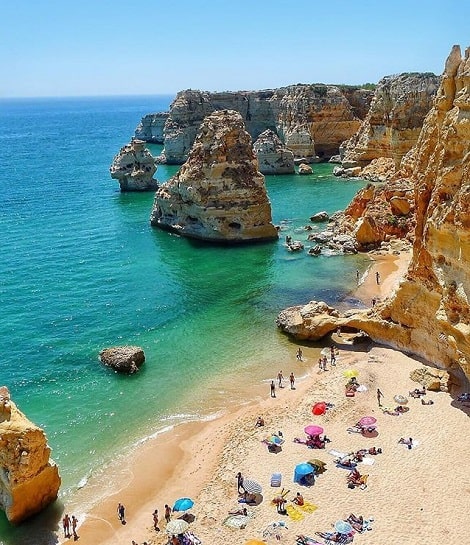
Welcome to Algarve International Travel!
Our company Algitravels provides private Faro airport transfers and VIP taxi transfers around Algarve region, Portugal and Spain. We also offer amazing historical, art, shopping tours with experienced guides. You can book all services online using our secured booking system.
12 years of Excellence!
What we offer
Private transfer to/from Faro airport
Private VIP taxi in Algarve region
Rent a car, bicycle or scooter in Albufeira
Biggest ticket shop for Algarve attractions
Our happy travelers

Thank you for wonderful trip to Sevilla. Everything was very well organized. Great transfer and experienced guide. Plus we had time for shopping!

Very reliable airport transfers. Car comes in time. Driver always meet me at the entrance of arrivals. Great service.

Went to Fatima with my girlfriend. Tour was organized by Algitravels. All was great, but had to get up really early! Was worth it thou. Thank you!!
or continue with
Reset Password
Enter the e-mail address associated with the account. We'll e-mail a link to reset your password.
WhatsApp us

The Algarve
Already a well known destination for family beach holidays and for golfers, the Algarve has much, much more to offer.
Whether you’re a first time visitor or you’ve been here before, just let us show you a fantastic region, with a lot to offer.
Once here you can call on our local knowledge and experience to help you enjoy all those aspects of the Algarve which have made it such a popular and well loved resort.
The best places to Visit in the Algarve Region are:
The old village which gives the name to the highest mountain in the Algarve region. A place where you can have views of cork tree fields, visit a medronho distillery (typical drink from the region), live museums, and much more.
The origins of the picturesque Alvor fishing village date back to the times of the Moors when it was an important port. Although there is no built heritage from those times, the town’s historic centre is well worth a visit if only for the opportunity to admire the striking beauty of the Manueline style Matrix Church entranceway. Nature lovers should be sure to ensure their stay includes a visit to the Alvor Estuary with its series of lagoons considered of international ecological importance given their role as a stopover point for migratory birds on their north-south journeys.
The most southwestern point of Europe, Where nature and sea meet history. This Region is marked by its mystical atmosphere and its unspoilt, dramatic landscape, where the sea and the hills come together creating a unique heritage. This is where you unspoilt natural beauty at his best with rugged beaches, peaceful bays, unique, untouchable landscapes, complemented by a profoundly rich Historical Heritage of international significance, with the Lighthouse, fortress and the beautiful small harbor of Baleeira.
In its churches, museums and bustling squares, Lagos reveals its ties with the sea. The first slave market of Europe, the beautiful church of Saint António, is the Marina, a meeting point with all the people and bars for a lively late afternoon drink, the D.Henrique square, now the place to be for the best in local handicrafts, are just some of the highlights from the 14th Century town.
Located 10 minutes drive west of Lagos in the Algarve Portugal, a unique village, peaceful, unspoilt (almost) and friendly. Its unique charm is the villages ability to appeal to everyone, regardless of age or interests. What you will take away if you visit Burgau (along with a suitcase full of local spirits and pottery) is a memory to treasure and more than likely one you will keep returning to mentally or physically.
Visit the medieval town of Silves, located inland, close to the mountains, between endless orange fields. A place where you can admire the beautiful 13 th century church, the Moorish castle, the fantastic historic centre, with his narrow streets. Silves played a role in the first phase of the discoveries, the daring voyages of exploration inspired and orchestrated by Prince Henry the Navigator (1394-1460), who established the Algarve as a centre of maritime know-how.
The capital of the Algarve, with its lively and bustling centre packed with stores, terraces and restaurants and with the best in seafood, will surprise you every step of the way. Besides the shopping area of Street Sto. António, is worth visiting the Castle walls, the narrow streets with archways and alleys lead onto the Afonso III square where the statue of the king recalls the city’s conquest in 1249.
This the name given to an area rather than to any actual town. It is outstanding in that it is one of the largest single tourist complex in Europe and covers some 2.000 hectares of land. A paradise for golf, with his 6 golf courses, a safe harbor with his huge marina. Vilamoura is a special place, a unique leisure and recreation resort community where the pace of life is so easy it feels like summer all year round.
Some consider this village, which has existed since the period of the Roman occupation, to be the village most typical of the Algarve. With their whitewashed houses, windows and façades with colorful borders, and decorated chimneys, the streets of the historical centre retain its original charm and tranquility. The area around the church is a delightful snapshot of the real Algarve.
This small village has kept a good deal of its original design, presenting a very typical square, along with a church that has an interesting interior décor. In one of its far ends lays a traditional restored waterwheel. In its surroundings, you will find one of the jewels of the Algarve landscape, Fonte Benémola, preserving one of the best examples of the primitive vegetation of Barrocal, situated in the border between Algarve coastline and the mountain.
Arriving by the bridge over the river, we can see how Nature was generous to this city. First of all, the river estuary made it possible to develop a riverside front that was used for decades as merely a quay for fishing boats. Its privileged location in the surroundings of exceptional beaches makes all the difference, and this is, in fact, Portimão’s greatest added value. The best of these beaches is Praia da Rocha beach, a spectacular sand area, not only because of its extension, but also of its width. The sand seems to have grown between the rocks, emerging here and there as islands in an ocean. Born place of the last President of the 1st Portuguese Republic, writer Manuel Teixeira Gomes, Portimão has all the entertainment and infrastructures that modern tourism is supposed to provide, being a superb place for shopping and eating.
It is one of the few remaining unspoilt working Algarve fishing villages. Situated at the mouth of the River Arade it has beautiful views across the river to Portimão and Praia de Rocha. There are pretty cobbled streets with old fishermen’s cottages, a church high up with great views along the river to the suspension bridge, and several good fish restaurants on the quay. There is also Praia Grande, dominated by the castle which was once a look out fortress but is now an impressive residence in private ownership.
It is as if there were two different Albufeiras. On the one hand, the small fishermen’s village that enchanted the British artist Cliff Richards, as well as other famous visitors. On the other hand, the city that was built for tourism, developing around an old coastal village of white houses, Moorish arches, hotels located by the sea and, above all, an impressive profusion of tourism villas, discos, restaurants and so on. Some of the most famous and sought-after beaches of the Algarve are located in this council, such as Olhos de Água, Oura, Balaia or the magnificent Barranco das Belharucas beach.
A former fishermen’s village by the sea, now converted in a picturesque seaside resort with pleasant resorts and summer houses in the middle of fig trees and almond trees. Even though it has a narrow sand area, it hides in its cliffs breathtakingly beautiful spots, such as the famous Algar Seco cave and the gouts of distant Benagil beach.
A city situated in a hill a dozen of kilometers away from the sea, is the headquarters of a council with pretty diversified characteristics. In terms of heritage, it is worth visiting São Lourenço Church in Almancil, as well as the historical centre of council’s headquarters with many vestiges of the medieval wall and other interesting curiosities, as for instance an old market. This city also organizes one of the most popular carnival celebrations in the country, bringing back tourists in low season.
The city was conquered by the Christians, to the Moors in 1242, but the Islamic populations have remained here, in the first quarter to be built outside the city walls. Tavira’s golden era lasted from the 15th to the following century, stimulated by intense trade relations with North Africa and Flemish commercial centers. The river mouth lies here and this river flows through the city. It has a Medieval bridge, which is now a pedestrian area. But there are more bridges both upstream and downstream. Some call it the city of bridges. To others this is the city of churches. Tavira is proud to have had over 60 churches. Nowadays it has less than half that number.
WhatsApp us
The Algarve Travel Guide
Book your individual trip , stress-free with local travel experts
Select Month
- roughguides.com
- Travel guide
- Itineraries
- Local Experts
- Travel Advice
- Accommodation
Plan your tailor-made trip with a local expert
Book securely with money-back guarantee
Travel stress-free with local assistance and 24/7 support
Just wanted to express my thanks to Joel and Rough Guides for a wonderful trip! Everything was well-chosen and we just loved all of the hotels, sightseeing...
With many of the country’s safest and loveliest beaches, and a year-round balmy climate, it is not surprising that the Algarve is the most popular holiday region with some of the best beaches in Portugal . The Algarve is the most southern region in Portugal, stretching the southern Atlantic coast from Vila Real at the border to Spain in the east to Sagres in the west.
Places to visit in the Algarve
Olhao and the islands, cacela velha, vila real de santo antonio and around, the central algarve resorts, armacao de pera, the serra de monchique, the western algarve, the west coast of portugal, carvoeiro and around, travel ideas for portugal, created by local experts.

7 days / from 3062 USD
Iberian Blend - Porto and Galicia
Neighbour countries - Portugal and Spain, different and similar at the same time, will surprise you with hospitality and loveliness. This itinerary includes the route of the Northwest part of Iberian Peninsula and offers you to meet beautiful Porto and stunning Vigo in Galicia/Spain.
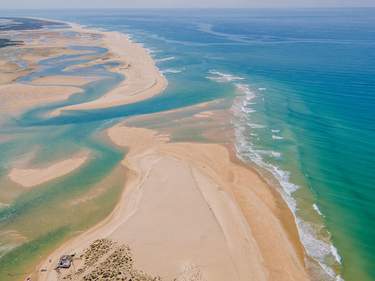
7 days / from 3019 USD
The Real Algarvian Experience
Experience and discover the real Algarve – taste local produce, drinks and traditional dishes, visit heritage sites and participate in culinary activities. If you are passionate about the people’s culture and gastronomy and want to learn more, this itinerary is for you.

11 days / from 1728 USD
A self drive to Portugal's North and Center
Starting in fascinating Lisbon, this trip allows you to discover Portugal both on your own as well as with guided tours. Driving further up north you'll explore Coimbra and Porto before heading to the Douro Valley and Alentejo.

8 days / from 1139 USD
Porto and the North of Portugal: off the beaten track
From Porto, you'll discover the most fascinating parts of Northern Portugal: go on a hike through unique biodiversity around the Paiva river, take a jeep tour through the slopes of the Serra da Arada and taste the wonderful wines of the Douro valley.

12 days / from 1690 USD
The best of Portugal: Lisbon, Porto and the Algarve
Portugal offers many highlights but when you're short on time, this trip is ideal to cover all the highlights: the capital city of Lisbon, historic Porto, lush Douro Valley and the stunning beaches of the Algarve are all part of this trip.

7 days / from 2662 USD
Azores Wild Nature
Get ready to discover what the largest island of the Azores, São Miguel, has to offer in this short adventure-packed 6-day trip. You will get to swim with wild dolphins, abseil or jump down waterfalls, ride a mountain bike through the Sete Cidades and relax in a natural spa. Adventure awaits!
When deciding where to go in the Algarve, take into consideration that stretches of the central coast between Lagos and Faro are mostly heavily developed, especially Faro. But even here the beaches are first-rate, as are the facilities. Also there are areas in the western Algarve around Sagres and Tavira where the surroundings are more attractive, with laidback resorts and low-key development.
To the west of Vilamoura, you’ll find the rocky outcrops and cove beaches for which the Algarve is best known, especially around the main resorts of Albufeira , Armacao de Pera (Armação de Pêra) and Lagos . The coast becomes progressively wilder as you head west, where attractive smaller resorts include the former fishing villages of Burgau or Salema, and the historic cape of Sagres – thought to be the site of Henry the Navigator’s naval school. The string of villages along the rougher west coast, as far as Odeceixe, are quieter still, with limited facilities but fantastic wild beaches ideal for surfing.
The eastern coast between Faro and the Spanish border is very different. Most of it is protected within the Reserva Natural da Ria Formosa, a series of barrier islands fronted by extensive sandy beaches. That means taking a short boat trip to reach the sands, which has helped preserve the towns from large-scale development. The resorts here have a more Portuguese feel than those in the central stretch, and first-choice bases here would be Faro itself – capital of the entire region – as well as Olhao, Fuseta, Cabanas or Tavira , all of which offer easy access to the sandbank islands.
Inland Algarve is still relatively undeveloped, especially around Alcoutim on the Spanish border. The Roman ruins of Milreu and the market town of Loulé are both worth an outing from Faro, while the old Moorish town of Silves is easily accessed from Portimão. Towards the west of the region, Caldas de Monchique is a quaint spa town in verdant woodland that makes up much of the picturesque Serra de Monchique mountain range.
Ready to explore Portugal? Start preparing by finding out how to get there .

Traditional portuguese town of Olhao, Algarve, Portugal © S-Studio/Shutterstock
There are few actual sights in Olhao (Olhão), 8km east of Faro . Still, with a vibrant market, attractive riverfront gardens and atmospheric backstreets, it’s an appealing place to spend some time. It also makes a great base from which to visit the surrounding sandbank islands of Armona and Culatra or the Quinta da Marim environmental centre.
The largely pedestrianized old town boasts some superb tile-fronted buildings, quirky shops and bars, while the flat roofs and narrow streets are striking and give a North African look to the place – perhaps not surprisingly, as Olhao had traditional trading links with Morocco.
The town was granted its charter by exiled king João VI to thank the local fishermen who sailed a small boat, O Caíque de Bom Sucesso, across the Atlantic to Brazil in 1808 to give him the good news that Napoleon’s troops had left Portugal. The amazing journey was completed with the most basic navigational aids. Today, a replica of the boat is moored on the water behind the market. It occasionally runs boat trips along the coast, ask at the turismo for details.
Around 10km east of Olhao, the fishing town Fuseta (Fuzeta) is one of the least “discovered” resorts on the Algarve. It is served by regular bus as well as the main Algarve rail line, probably because of its shortage of accommodation. It is not the most beautiful town in the region, but it retains some character as a working fishing port. Its daily routine revolves around its fishermen, whose colourful boats line up alongside the river in town. In summer Fuseta also attracts a lively community of campers. The two communities usually mingle at the line of lively kiosk-cafés spreading down from the ferry stop towards the river beach.
The town’s backstreets straddle a low hill facing the lagoon, sheltered by the eastern extremity of the Ilha da Armona. Many of the local fish find their way to the small covered market on Largo 1° de Maio, on the road running parallel to the river. On Saturdays the market expands into a flea market that lines the adjacent pedestrianized Rua Tenente Barrosa. Continue up this road to reach the town’s little palm-tree-lined central square.
The waterfront of modern shops and apartments faces broad gardens that are largely taken over by the campsite. Beyond this is the estuary beach, a fine stretch of white sand that weaves up to a wooden lifeboat house, though more exhilarating and cleaner waters are found over the lagoon on the Ilha da Armona.
Six kilometres east of Tavira – past the golf course at Benamor – lies Cabanas, named after the fishermen’s cabanas (huts) that formed the original settlement. Today a kernel of backstreets is still made up of pretty fishermen’s houses along with a line of low-rise shops, cafés, restaurants, and bars facing a picturesque river estuary edged by a neat wooden walkway. Moored fishing boats testify to the village’s former mainstay, though today the economy is largely driven by tourism thanks to the glorious sands on Praia de Cabanas over the estuary.
Things to do in Cabanas
Ferries shuttle passengers to the Praia de Cabanas from a small jetty opposite Restaurante O Monteiro in the east of town. Cross the dunes and you’re faced with kilometres of golden sand, plus a couple of seasonal beach cafés. A perfect spot for swimming, sunbathing and relaxing before grabbing a yummy lunch or sunset dinner.
There are three golf courses in the area for golfers, a 17th century Sao Joao da Barra fort, now turned into a luxury seafront hotel for those who love relaxing. For nature lovers, you can take a boat ride to the waterways of the Ria Formosa Natural Reserve, ideal for birdwatching.
Best time to visit Cabanas
The best time to visit Cabanas is typically during September and October, when the temperature is in the high 20s. The Summer months are of course the hottest, with temperatures sitting in the mid 30s. Spring is cooler, as with winter, at around 17 - 20 degrees; perfect if you want some winter sunshine.
Perched on a low cliff facing the estuary, 10km east of Cabanas, the whitewashed village of CACELA VELHA is a reminder of how the Algarve must have looked half a century ago. Apart from a few café-restaurants, there are no tourist facilities, just a pretty church and the remains of an eighteenth-century fort – and even that houses a maritime police station and is closed to the public. Offering exhilarating views from its clifftop, Cacela is highly picturesque and, despite the Quinta da Ria/Quinta da Cima golf courses just to the west, it’s rarely overrun by visitors. The only time the place gets busy is during the Moorish Nights in July – a four-day festival of Arabic food and Moorish-inspired events, including a souk.
The beach below the village has been rated as one of the best in the world, and it would be hard not to agree. To get to it, follow signs to “Fábrica”, just west of the village, around 1km downhill. From here a ferryman can take you over to the beach (daily in summer, but only during good weather the rest of the year).
Vila Real de Santo Antonio (aka Vila Real) is a pleasant border town, the terminus for the trans-Algarve railway line. The ferry across the Guadiana from here to Ayamonte is still the most fun way to cross the border. The construction of a modern road bridge just north of the town in the 1990s greatly affected the town’s former role as the Algarve’s main access point to Spain.
Nevertheless, it’s still an interesting place to spend a few hours, exploring a central grid of streets that radiates out from a handsome main square, Praça Marquês de Pombal, ringed by orange trees, low, white buildings and pleasant outdoor cafés. The square is named after the king’s minister, who helped rebuild the original town after it was destroyed in a tsunami following the 1755 earthquake. Indeed the grid plan, dating from 1774, is very similar to that of Lisbon’s Baixa.
On the north side of the square, Rua Teófilo Braga, the pedestrianized main street, leads inland from the riverfront Avenida da República to the Centro Cultural António Aleixo, the town’s former market building now used as an innovative space for temporary exhibits and the occasional film, and which also dispenses tourist information. The streets surrounding the cultural centre have a certain low-key charm, bristling with linen shops, electrical retailers and grocers, while the riverside gardens offer fine views across to the splash of white that is Ayamonte in Spain.
Some 40km north of Vila Real – and best approached by car along the road that hugs the Guadiana River – is the extremely attractive border village Alcoutim. It has a long history as a river port, dominated in turn by Greeks, Romans and Arabs who all fortified the heights with various structures; the castle dates from the fourteenth century and offers fine views over the river.
The entrance fee includes access to a small archeological museum by the main gates, which traces the history of the castle, its active service in various battles and the remnants of earlier structures on the site. From the castle, cobbled backstreets lead down to the small main square, below which is the appealing riverfront. Currents are too strong for safe swimming, but you can take a boat across the river to the Spanish village of Sanlúcar, a mirror image of Alcoutim, with its own ruined castle; or swim at the river beach (praia fluvial) in a small tributary off the Mértola road.
The central Algarve from Faro to Lagos encompasses some of the region’s best beaches – but also its most intense tourist development. Despite this, Quinta do Lago, Vale do Lobo and Vilamoura are low density and upmarket: purpose-built resorts with great facilities including marinas, top golf courses and tennis centres. These resorts don’t have much traditional culture, though there’s a little more of that at neighbouring Quarteira, a high-rise resort with a fine town beach and a renowned fish market.
For Getting around Central Algarve resorts, a road train trundles along the seafront, round town and back to the market every hour or so.
LOULÉ, 18km inland from Faro , has always been an important centre of commerce and is still best known for its markets. It has recently grown to a fair size, though its compact centre doesn’t take long to look around. The most interesting streets, a grid of whitewashed cobbled lanes, lie between the remains of its Moorish castle (now a museum) and the thirteenth-century Gothic Igreja Matriz, with its palm-lined gardens in front.
Armacao de Pera (Armação de Pêra), 15km west of Albufeira , fronts one of the largest beaches in the Algarve, which spreads east all the way to Galé. Beach aside, it is not the greatest looking of resorts; high-rise buildings and apartments straggle along the town’s main through-road, tempered only by a pedestrianized promenade overlooking the central part of the sands.
The remains of Armacao de Pera’s fortified walls are at the eastern end of the resort, where a terrace in front of a little white chapel provides sweeping views. But the town beach is fine and if the main section is crowded, just head further east, beyond the cluster of traditional boats on the fishermen’s beach towards Galé, where things are quieter. Aside from the beaches, the other local attraction is 4km up the main N125 at Porches, where the most famous of the Algarve’s chunky and hand-painted pottery comes from – the main road is lined with shops that sell it.
Eighteen kilometres northeast of Portimão, with a superb castle whose dramatic ring of red walls gradually reveal themselves as you approach, SILVES is well worth at least a half-day’s visit. While under Moorish occupation, the town was the capital of the Algarve – indeed it was the Moors who named the region al-Gharb (“the west”), and built Silves into a well-fortified and sophisticated place. The town’s golden age came to an end, however, in 1189 with the arrival of Sancho I and his large, unruly army of Crusaders, who laid siege to thirty thousand Moorish inhabitants in the citadel for three months. When the Moors’ water and food supplies finally ran low they agreed to open the citadel gates in return for Sancho guaranteeing the safety of its inhabitants. The Crusaders, however, ignored Sancho’s pledge and killed some six thousand Moors as they gleefully took the fortress. Silves passed back into Moorish hands two years later, but by then the town had been irreparably weakened, and it finally fell to Christian forces for good in 1249.
The Serra de Monchique is a rolling mountain range separating the Algarve from the neighbouring Alentejo district. Its slopes are made up of deciduous oaks and chestnut woods and it’s one of the few areas of Portugal that shows off dazzling autumn colours. Its highest peak – at nearly 900m – is Fóia, from where, on a clear day, the views stretch over the south coast of the Algarve and west across to Cabo de São Vicente. Sadly this area also bears the brunt of the summer fires that seem to rage annually, though the woodland is generally quick to recover.
Caldas de Monchique
Set in a beautifully wooded ravine, CALDAS DE MONCHIQUE was a spa even in Roman times and was once popular with Portuguese royalty. It was sympathetically restored in 2000, transforming a somewhat ramshackle spa resort into a tourist village – and the results have been fairly successful. The cobbled, tree-shaded main square, fronted by the pseudo-Moorish windows of the former casino (now an exhibition hall), is surrounded by lovely nineteenth-century buildings and the wooded setting is a delight. At the foot of the village, the modern thermal spa offers specialist treatments – including water massage, jet-showers and a steam room.
MONCHIQUE, 6km from Caldas, is a sizeable hilltown best visited for its market, held on the second Friday of each month (by the helipad): check out the local smoked hams and distinctive wooden furniture – especially the distinctive x-shaped chairs. There’s also a weekly Sunday market on the main square, Largo 5 de Outubro, though the town is liveliest during the Feira dos Enchidos Tradicionaes (Traditional Sausage Fair) in March, when restaurants lay on special menus. The old town is dotted with beautifully crafted metal sculptures of local characters made by a contemporary Lisbon artist, which you can spot on the waymarked route to the ruined seventeenth-century monastery of Nossa Senhora do Desterro, signed uphill from the bus station. Only a rickety shell of this Franciscan church remains, but it’s a lovely fifteen-minute walk up.
There’s a beautiful, winding 8km drive from Monchique up to the Serra’s highest peak at Fóia, though the summit itself – bristling with radio masts, and capped by an ungainly modern complex sheltering a café-restaurant and shop – can be an anticlimax, especially if clouds obscure the views. On a clear day, however, the vistas are superb.
The coast west of Lagos , as far as Sagres , remains one of the least spoiled parts of the Algarve, largely thanks to the Parque Natural da Costa Vicentina which prohibits large-scale building on the coastline west of Burgau. As a result, the resorts – certainly west of Luz at Burgau and Salema – remain largely low-rise and low-key. Most of the coast is linked by a craggy coast path and you can easily walk between the villages: Salema to Luz, or Luz to Lagos , in particular, are beautiful routes.
Once past the modern suburbs, Burgau, 5km west of Luz, is a pretty little former fishing village of narrow cobbled lanes which tumble down a steep hillside to a fine sandy beach set below low cliffs. Fishing boats still line the lower roads, which double up as slipways, while narrow alleys weave around to a miradouro viewpoint. In July and August the village is somewhat mobbed, but at other times it retains a distinct character, with locals cooking fish on tiny grills outside their homes.
At the bottom of an attractive valley, Salema is no longer the thriving fishing village it once was, but its tight warren of fishermen’s houses above the eastern end of a fine, sandy bay now form the hub of an attractive resort. Many of the old houses are now converted into inexpensive holiday lets: look for signs in the windows. A plume of modern development spreads steeply uphill, but at least the white villas are in keeping with the old town, and its beach only gets busy in high season.
The west coast of the Algarve faces the full brunt of the Atlantic, whose crashing breakers and cooler waters have largely deterred the developers. Nevertheless, the rocky coastline is punctuated by fantastic broad beaches accessible from the small villages of Carrapateira, Odeceixe or, a little further inland, Aljezur.
This is popular territory for surfing, camping and hardy nudists who appreciate the remote beaches. Be warned though: the sea can be dangerous and swimmers should take great care. In 1995 the stretch of coast from Burgau to Cabo de São Vicente and up through the Alentejo was designated as a nature reserve, the Parque Natural da Costa Vicentina. This afforded the rugged scenery a certain amount of protection, though it also means that accommodation is scarce and it is better to have your own transport.
Aljezur (pronounced “alj-ezoor”), 16km north of Carrapeteira, is the liveliest town on this coast, though some way inland from any beaches. The main coast road passes through a prosaic, modern lower town where you find banks, the post office and a range of cafés and restaurants. The more interesting historic centre spreads uphill beyond the bridge over the Aljezur River, a network of narrow cobbled streets reaching up through whitewashed houses to the remains of an eleventh-century Moorish castle, a lovely picnic spot and where you can see the remains of the cistern and grain silos. It’s a lovely walk up to the castle with sweeping views over the valley, via a cluster of museums (see also Walks in and around Aljezur).
The Casa Museu Pintor José Cercas displays the works and collections of local artist José Cercas, who lived in the house until his death in 1992. His well-observed landscapes and religious scenes are complemented by the attractive house and pretty garden.
Some 10km southwest of Aljezur, Praia da Arrifana is a superb, sandy sweep set below high, crumbling black cliffs which shelter a tiny fishing harbour. The beach is excellent, and surf competitions are sometimes held here. Several simple café-restaurants lie along the road above the beach, all serving grilled fish at moderate prices.
Walks in and around Aljezur
The active historical society in Aljezur has marked out an attractive 4km Circuito Histórico around the old town, with historical sights marked by plaques in English and Portuguese. Before the river silted up in the fifteenth century, Aljezur was a major port, and the route passes buildings such as the tollhouse, once used to check weights and goods as they arrived. The town also marks the crossover point of two major long-distance walking trails: the Via Algarviana, which runs for 300km from Alcoutim in the west to Cabo de São Vicente in the south; and the Rota Vicentina, which runs for 340km from Santiago de Cacém in the Alentejo, sharing the southern route to Cabo de São Vicente with the Via Algarviana.
The attractive village of Odeceixe tumbles down a hillside opposite the broad valley of the Ribeira da Seixe, below the winding, tree-lined main coast road. Sleepy out of season, its character changes in summer when it attracts a steady stream of surfers, campervanners and families, lured by a superb beach and a very laidback atmosphere. Everything centres on the single main street and a small square, Largo 1 de Maio, where you’ll find some lively bars, plenty of cafés, a couple of minimarkets, post office, bank and craft shops.
The beach, Praia de Odeceixe, is 4km west of the village, reached down a verdant river valley, the fields either side neatly cultivated with corn. A road-train trundles between village and beach during July and August, but it’s a lovely walk along the road as well, following the river to a broad, sandy bay framed by low cliffs. Praia de Odeceixe is one of the most sheltered beaches along this stretch of coast, offering superb surfing and relatively safe swimming, especially when the tide is out. There’s lots of parking above the bay, as well as a cluster of houses and cafés, some offering quartos (rooms to rent).
Carrapateira and its beaches
Some twenty kilometres to the north of Sagres is the low-key village of CARRAPATEIRA. There’s not much to the village itself, but most people are drawn by the nearby Praia da Bordeira, a spectacular beach backed by giant dunes, a tiny river and crashing surf. A couple of kilometres south of Carrapateira (signed off the main road), there’s a further fantastic broad, sandy bay, Praia do Amado, with a couple of seasonal cafés. Backed by low hills, it’s particularly popular with surfers, and there’s a surf school here.
A whitewashed former fishing village nestled into sea cliffs, the small resort of Carvoeiro must once have been very attractive, but now its small cove beach has to support the prostrate bodies of hundreds of tourists shipped in to what has become an overblown resort.
Things to Do in Carvoeiro
Apart from the obvious activities such as swimming, sunbathing and generally just relaxing and enjoy the beach, there are other places to explore should you want more of an adventure. From the beach itself, local fisherman run boat trips to the nearby caves. You can also visit the impressive rock formations of Algar Seco, 1km east of town, where steps lead down low cliffs to a series of dramatic overhangs above blow holes and grottoes. They are accessible via the coast road, or by a road train that trundles out from Carvoeiro every hour or so.
There are two superb cove beaches a few kilometres to the west of Carvoeiro, though you’ll need your own transport to reach them from town. First up is Praia da Caneiros, with a rock stack jutting from the sea off its lovely beach and a superb beachside restaurant, Rei das Praias. A couple of kilometres further on, Praia Pintadinho is almost as appealing, with a simpler café-restaurant.
Best time to visit Carvoeiro
The Summer months in Carvoeiro can be quite hot, the best time to visit the Algarve region is between April and June, when temperatures sit nicely at around 25 degrees, the same for September and October. It is never particularly cold, with the lowest avergae temperature sitting at 11 degrees in January, when rainfall is at its highest.
Around Carvoeiro
Carvoeiro is a small town, so once you've explored it's streets and relaxed on the beaches, you may be looking for a day trip. Nearby is Silves, a historical town with a Moorish castle and pretty riverside walks. A nice way to see Silves is by taking a boat trip up the Arade River from Portimao.
Facing the sprawl of Portimão across the Rio Arade estuary, FERRAGUDO is an attractive former fishing village centred on a strip of palm-fringed gardens that spread up to the cobbled main square, Praça Rainha Dona Leonor. A waterfront promenade lined with fish restaurants skirts the estuary – you can take various boat trips from here, most linking up with those departing from Portimão.The old town spreads steeply uphill behind the estuary, its warren of atmospheric cobbled backstreets gathered around Ferragudo’s church, with a terrace that offers great views. The town has an estuary beach, which gets progressively more appealing as it approaches the impressive Castelo de São João do Arade. The castle (closed to the public) faces its partner fort in Praia da Rocha across the river, both of which were built in the sixteenth century to defend Portimão against attack.
The nearest ocean beach lies a couple of kilometres south, where you’ll find the broad sands of Praia Grande at the mouth of the Rio Arade, with a scattering of restaurant-bars.
Sited on the broad estuary of the Rio Arade, Portimão has made its living from fishing since pre-Roman times, but today it's a sprawling modern port of around forty thousand people. Few of Portimão’s buildings made it through the 1755 earthquake – the Igreja da Nossa Senhora da Conceição is a rare survivor, retaining a fourteenth-century Manueline door, though most of the church was rebuilt in the late seventeenth century. The surrounding streets are pleasant enough, filled with shops selling lace, shoes, jewellery, ceramics and wicker goods, while the main shopping streets are around the pedestrianized Rua Diogo Tomé and Rua da Portades de São José.
The most attractive part of town is the riverfront, where a series of squares – Largo do Dique, Praça Manuel Teixeira Gomes and Praça Visconde de Bivar – are filled with outdoor cafés by gushing fountains. Heading up the river and under the road bridge you’ll find a series of open-air restaurants serving inexpensive grilled-sardine lunches. The narrow streets just back from the bridge – off Largo da Barca – are Portimão’s oldest, with more than a hint of their fishing-quarter past.
Set slightly inland on the Rio Alvor, the port of Alvor, 6km west of Praia da Rocha , briefly achieved fame as the place where Dom João II died in 1495. Although much of the town was razed in the 1755 earthquake, it still boasts a sixteenth-century Igreja Matriz with Manueline doors and pillars carved into fishing ropes and plants. Despite the inevitable development, the old core around the church and the central Praça da República retains some character, while the harbour itself is a delight, lined with colourful fishing boats and aromatic fish restaurants. Two-hour boat trips to various places along the coast leave from here. From the harbour it's a short walk uphill to the ruins of Alvor’s castle, which dates back to the thirteenth century but now houses a children’s playground.
Exploring Alvor
From here, Rua Padre David Neto leads onto Rua Dr Frederico Romas Mendes, the main drag lined with bars and restaurants. This stretches down to the riverside Largo da Ribeira, marked by a modern statue of a fish, where you’ll find half a dozen fish restaurants overlooking the picturesque Rio Alvor. Head right as you face the river and a path leads up the estuary for a tranquil walk; bear left and it is a ten-minute stroll past fishermen’s huts and riverside cafés to the Praia de Alvor, an enormous beach backed by café-bars.
Praia de Alvor
Praia de Alvor is a beach of stunning measures - spanning several kilometres, the sands are soft and the waters blue. You will find a long boardwalk close to the beach that leads you to the pretty Ria de Alvor Nature Reserve. When you're not busy enjoying the beach and sunshine, check out the local church and castle.
Getting to Alvor
If you are staying in the town of Alvor, the beach is just a short walk away. From Lagos and Portimao there are buses to the village, and if traveling by car; Alvor is well sign-posted. Close to the beach is a parking lot that is shockingly cheap at 1.50€ for the full day.
Related articles from the blog

Discover more places in Portugal

- Sagres and around
- Tavira and around
The Rough Guides to Portugal and related travel guides
In-depth, easy-to-use travel guides filled with expert advice.
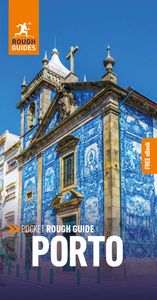
Find even more inspiration here
Planning your own trip prepare for your trip.
Use Rough Guides' trusted partners for great rates

written by Mani Ramaswamy
updated 07.06.2024
Ready to travel and discover Portugal?
Get support from our local experts for stress-free planning & worry-free travels.
- Where to stay
- Travel advice
For full functionality of this site it is necessary to enable JavaScript. Here are the instructions how to enable JavaScript in your web browser .

- Algarve Bus & Train Guide – Top tips, Routes, Prices & Fares
- Top Tips for your Holiday in the Algarve
Guest Post by Thomas Allen
There is no single official source of information for public transport in the Algarve however below is a guide to help you get started. For more detailed information you can also visit Algarve Bus Info a private website maintained by a British resident of the Algarve which includes train and bus timetables, plus links to official websites.
FARO AIRPORT
There is a local bus once or twice an hour every day between the airport and the railway and bus stations in Faro city centre. The fare is €2.25 and it takes about 20 minutes. For more information and times see here .
A railway line runs between Lagos in the west and Vila Real de Santo António in the east. Click to see larger size.

Some stations such as Albufeira and Loulé are several miles from the town itself. Train times are irregular and on the Faro – Lagos section trains are rather infrequent. The current official timetable (in English) can be downloaded here .
Unfortunately tickets cannot be purchased online, with an app or in advance. You buy tickets at the station ticket office (if there is one) or if there isn’t from the train conductor when you get on. Train conductors accept only cash. Over 65’s travel half price however ID is required. Children aged 4 -12 also travel half price.
Those with mobility issues should note that the trains currently used in the Algarve have steps up into the carriages and therefore this may cause problems especially if travelling alone.
If needed, this page at Algarve Bus Info has further information about trains, including those that run to and from Lisbon.
LOCAL BUSES BETWEEN TOWNS AND VILLAGES
Most buses used are suitable for those of reduced mobility, but some are not. Unfortunately on some routes it not possible to predict what type of bus will come along!
These buses do not carry route/line numbers as they do in most other parts of the world. You must check the destination display on the front of the bus, which is often just a paper sign pinned in the driver’s window.
All timetables are in the 24hr clock format. 13.00hrs = 1pm, 14.00hrs = 2pm etc.
In general, bus services linking the various towns and villages in the Algarve start around 07.00hrs on weekdays and finish by 20.30hrs, which means that, in most places, last buses are on their way around 19.30hrs. On Saturdays, Sundays and holidays first buses are fairly early, but there are, on many routes, a lot fewer buses than on weekdays. Last buses are often earlier than weekdays. Many villages out in the countryside have no buses at all at weekends or on public holidays. The main inter-urban routes do have weekend and holiday service, at reduced levels. Buses do not usually run at regular intervals (ie. at so many minutes past each hour).
This diagram shows the main routes in the western part of the Algarve.

Go to Algarve Bus Info for a more detailed background on buses.
The EVA bus company operates most inter-urban bus services in the Algarve. Their official website is www.eva-bus.com
Around Portimão, some buses are operated by Frota Azul (Algarve). Their official website is www.frotazul-algarve.pt/
Fares and tickets – interurban buses
When boarding at a BUS STATION/BUS TERMINAL you must usually buy tickets at the ticket office window. Tickets cannot be purchased online and there are no ‘apps’, so yoou pay the old fashioned way, using money!
If boarding at a stop, or when the ticket office is closed, have small change ready and pay the driver as usual. Drivers will give change, but they will not thank you if you hand over a €50 note!
Sample bus fares for adults :
- Faro to Lagos – €6.05
- Albufeira to Portimão and Praia da Rocha – €4.75
- Albufeira to Alvor – €4.85
- Albufeira to Lagos – €5.70
- Albufeira – Faro €4.85
- Albufeira to Armação de Pera and Vilamoura €4.25
- Silves – Portimão €3.35
- Silves – S.B Messines €4.25
- Albufeira to Silves, Quarteira or Loulé €4.45
- Monte Gordo to Tavira €4.25
- Monte Gordo to Vila Real €2.35
- Monte Gordo to Faro €5.70.
Both bus companies offer pre-paid smart card tickets for 5, 10 or 20 journeys between the same two places. These can reduce the fare by 40 or 50% but are only available at bus station ticket offices. The cards themselves cost €3 which is refunded if you give it back, but unused fares are not refunded.
A tourist pass is available for either three days or seven days consecutive and unlimited travel. Ask at bus stations for prices and conditions. One day tickets are not sold.

Bus Stops and Bus Stations / Terminals
Stopping places are indicated with signs. PARAGEM is the Portuguese word for bus-stop; helpfully many signs also display ‘Bus Stop’ in English. In rural areas, the bus stop sign may be only on one side of the road. The bus will stop on the opposite side if you are waiting. All bus stops are REQUEST stops. If you are waiting at a stop, give the bus driver a clear signal as the bus approaches. If you are on the bus and wish to get off, ring the bell in good time before your stop.
There are NO timetables shown at most bus stops. Make sure you know the bus times or where to find them online.
The larger towns have bus stations of various size and quality. If you are going to or from Albufeira, the main bus station is a mile (1.6km) from the town centre. Many buses stop nowhere else.
BUSES AROUND THE LARGER TOWNS
The larger towns in the Algarve have separate ‘urban’ bus operations. Tickets are different, the tourist pass mentioned above cannot be used on these. All ‘urban’ systems offer 1 day tourist tickets which you buy from the driver, who will also issue normal cash tickets. There are various pre-paid passes which reduce fares considerably. Passes are generally only available at bus stations. The Lagos and Portimão systems do have sales agents elsewhere.
There are NO discounts for children or seniors except for residents. Fares are as low as €1 on some systems, but €1,40 in Albufeira (80 cents with a pre-pay card) and €1,50 around Portimão, Alvor and Praia da Rocha.
A single fare in Albufeira, Lagos and Portimão is valid for 1 hour, allowing you to change buses to complete your journey without paying again.
These are towns with local bus systems. Click the name to go the relevant website. Some websites are only in Portuguese. You can also ask for information at the town’s bus station, tourist offices or visit www.algarvebus.info/alpha.htm and search by location. Most of the staff in the bus stations will speak some English, however it’s polite to ask rather than assume. Most of the buses on these local systems have wheelchair ramps.
ALBUFEIRA , FARO , LAGOS (incl Praia da Luz), LOULÉ , OLHÃO , PORTIMÃO AREA (incl. Alvor and Praia da Rocha), QUARTEIRA , TAVIRA , VILAMOURA
COACHES (LONG DISTANCE BUS) TO LISBON AND FURTHER
All the large towns and many smaller ones have several coaches every day to Lisbon and beyond. Website is www.rede-expressos.pt where times can be checked and tickets purchased up to 30 days before travel. You can also buy tickets at bus stations, but for journeys starting between about 2000 and 0600 the ticket office will not be open. Go there a day or two before or buy online.
COACHES (LONG DISTANCE BUSES) TO SEVILLE AND SPAIN
Two different companies run from the major coastal towns to Seville and beyond. Go to www.alsa.es or www.rede-expressos.pt for times and tickets. At most times of the year a day trip to Seville is impossible unless you start very early and wait until midnight to return! Day excursions run from most of the major tourist resorts.
HOP ON HOP OFF TOURIST SIGHTSEEING BUSES AND ‘TRAINS’
Most of the large towns have these. Some run all year, some in summer only. Hotels and tourist information offices will have information.

PUBLIC HOLIDAYS – these are always held on the day they fall (instead of always on Monday’s like in the UK), so don’t be caught out by a surprise Wednesday holiday when trains and buses run to Sunday times. Trains and buses do run on Christmas Day and New Year’s Day.
Check holiday dates at www.algarvebus.info/hols.htm
Username or Email Address *
Remember me Lost your password?
Username or Email
Get New Password

Algarve Itinerary – How To Spend 5 Days In The Algarve, Portugal
Posted on Last updated: June 10, 2023
Need help planning your Algarve itinerary? This guide is exactly what you need!
The Algarve is one of the most famous and visited areas of Portugal, and it’s easy to see why. With its pristine beaches, turquoise sea and dramatic golden cliffs, it’s a region of stunning natural beauty.
It’s the perfect destination for anyone searching for great beach holiday, but it’s also much more than that.
It’s perfect also for active travellers who want to surf, SUP or kayak, or for history fans that want to explore cute Portuguese towns.
In this article I will go over exactly how many days you need to visit the Algarve, a detailed day-by-day breakdown of the best activities and places to see, tips on where to eat, where to stay and more!
So what are you waiting for? Let’s dive in and start planning your perfect Algarve itinerary!
- 1 Do you need travel insurance to visit the Algarve?
- 2 How many should you spend in the Algarve?
- 3 How to travel around the Algarve
- 4.1.1 Tavira
- 4.1.2 Explore Faro
- 4.1.3 Beach & Nightlife in Albufeira
- 4.1.4 Where to stay in Albufeira
- 4.2.1 Sunrise kayak tour to Benagil Cave
- 4.2.2 Hike the Seven Hanging Valleys trail
- 4.2.3 Relax at Praia da Marinha
- 4.2.4 Do a stop in Carvoeiro
- 4.2.5 Visit Ferragudo
- 4.2.6 Spend the night in Lagos
- 4.2.7 Where to stay in Lagos
- 4.3.1 Visit Praia do Camilo
- 4.3.2 Hike along Ponta da Piedade
- 4.3.3 Relax at Praia de Dona Ana
- 4.3.4 Do a boat tour to Ponta da Piedade
- 4.3.5 Visit Praia dos Estudiantes
- 4.4.1 Surf at Praia do Telheiro, Praia do Amado or Castelejo Beach
- 4.4.2 Explore Sagres Town
- 4.4.3 Watch the sunset at Cabo de Sao Vicente
- 4.5.1 Where to stay in Sagres
- 5 What to pack for your Algarve trip

Enjoying the view over Ponta da Piedade in the Algarve, Portugal
Do you need travel insurance to visit the Algarve?
After my personal experience spending two nights in a private hospital in Tenerife, and having to pay for it out of pocket (it wasn’t cheap), I always recommend getting travel insurance .
You might not end up needing it, but for a small fee you can travel without worries. Personally, I suggest getting your travel insurance with Heymondo .
Heymondo offers tailor made travel insurance, providing the best value for money for your specific trip. You can also buy it once you’re already abroad and have forgotten about it before flying (which, if you’re anything like me, is quite likely).
Besides the usual cancellation, medical expenses, luggage coverage and general travel insurance services, Heymondo also has a 24/7 doctor chat and instant assistance through their app.
Plus, as a Greta’s Travels reader, you get 5% off your Heymondo travel insurance !
Click here to get your 5% off Heymondo travel insurance!

View over the beach and town of Carvoeiro in the Algarve, Portugal
How many should you spend in the Algarve?
If you’ve only just started planning your Algarve itinerary , you might be wondering how many days you should spend in the Algarve.
It ultimately depends on your personal interests and your overall Portugal itinerary , but I would say the bare minimum is 3 days in the Algarve.
In this guide I have included a day-by-day breakdown for my Algarve 5-day itinerary. Three days will allow you to see all the main sites, but you will be rushing around a bit, spending a lot of time driving from one place to the next.
If you spend five days in the Algarve you will have enough time to visit all the most famous spots, do fun activities and relax at some world-renown beaches.
For those who want to relax and spend more time at the beach, then you can easily spend up to one week in the Algarve, taking it slow at every beach and discovering all the gorgeous seaside towns.
So to answer your question; how many days should I spend in the Algarve? I would say 3 days is the bare minimum, but I personally recommend 5 days for an awesome Algarve itinerary.

The unique rock formations of the Algarve
How to travel around the Algarve
The easiest way to get around the Algarve is to rent a car and do an Algarve road trip. That way you will have the maximum flexibility over where you want to go and travel times.
There are also trains and buses that run across the whole region, but they might not go to the smaller towns or unknown beaches.
Especially if you’re travelling as a group of friends or family, renting a car might also work out cheaper than with public transport. Just make sure to check all the details of your car rental before booking.
I rented two cars in Portugal and both times we had to argue with the car rental, as they include lots of hidden charges and on one occasion they also didn’t include all the damage the car already had in the initial check-out document.
If you want to save money on your car rental, you can use Rental Cover for your car insurance. I always purchase my insurance for car rentals with them as they are much cheaper than the insurance rental companies offer.

The gorgeous Praia do Marinha – a must see on any Algarve itinerary
The best Algarve 5-day itinerary
Day 1: faro, tavira & albufeira.
Located a short 30-minute drive away from Faro, I thought I’d start this Algarve itinerary with something a little off the beaten path. This small city sits on the mouth of the Gilao River, and is right next to the famous Tavira Island.
This part of the Algarve coast is famous for its long sandy beaches and saltpans, which attract flamingos and other birds. They’re very different from the other beaches you will see in this Algarve itinerary.
Tavira town is also worthy of a visit. The old town centre is characterised by the typical Portuguese white houses and cobbled streets. There’s also the medieval Tavira Castle from which you get great city views.
You can also do a fun tuk-tuk city tour of Tavira ! That way you will have a local guide taking you to all the must-see spots, and telling you about the history of this cute Portuguese town.
Click here to book your Tavira tuk-tuk city tour , or check out prices & availability in the calendar below!
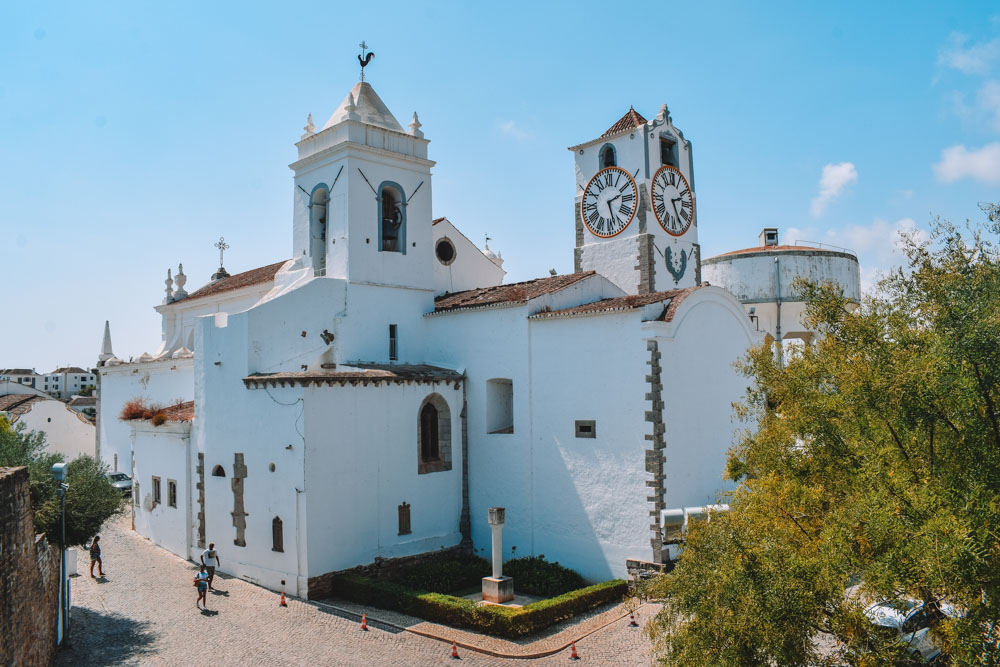
Igreja do Santa Maria do Castelo in Tavira, Portugal
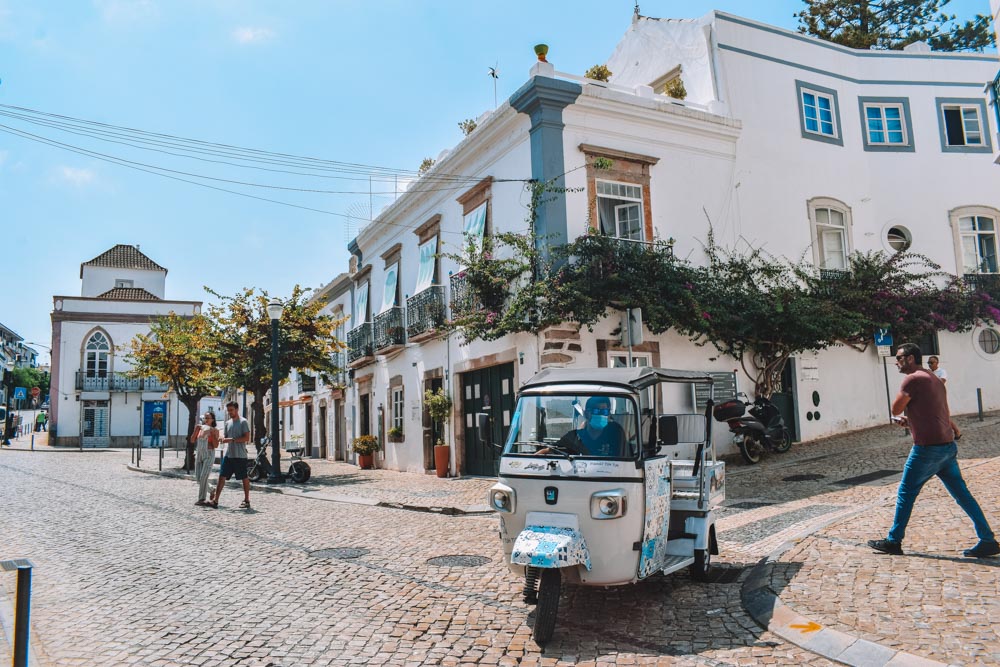
Exploring Tavira in the Algarve by tuk-tuk
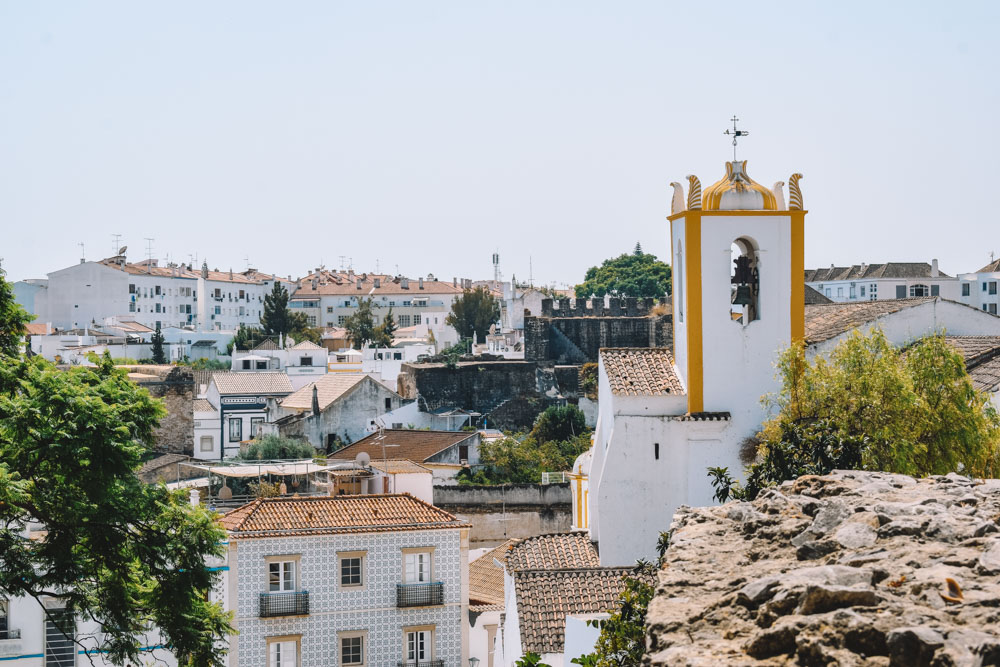
Rooftop views in Tavira, Portugal
Explore Faro
Being the capital of the Algarve, no Algarve itinerary would be complete without a visit to Faro. You can spend a few hours exploring the gorgeous old town of Faro, its unique architecture and quirky shops.
Some must-see sights are Arco da Vila, Faro Marina, Igreja do Carmo and Faro Cathedral. Walking around the white cobbled streets and cute white houses will give you all the Portuguese vibes you’re looking for.
After a busy morning of sightseeing you can sit down, relax a bit and eat at one of the many local restaurants. We ate at A do Pinto and had a delicious acorda, a traditional Portuguese dish. It looks ugly, but tastes delicious!
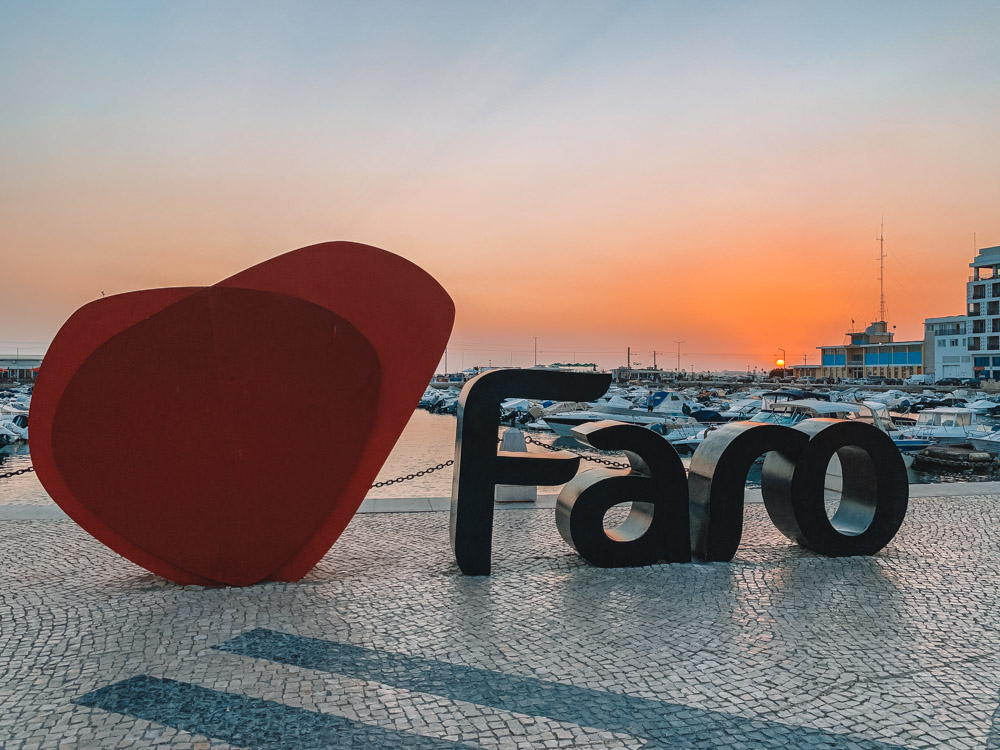
Sunset in Faro Marina, Portugal

Exploring Arco da Vila in Faro, Portugal
Beach & Nightlife in Albufeira
With a full belly it’s time to hit the road again! Albufeira is one of the most famous seaside towns in the Algarve, and it’s easy to see why. It used to be a fishing village, which became a major holiday hotspot.
You will find a huge beach waiting for you, where you can relax and tan after a busy sightseeing morning. Right behind the beach is the promenade and town centre, so that you can easily explore it.
The old town is perched on the hill above the beach. You can walk up there and wander around the cute white streets, as well as enjoying the epic view over the beach and coast.
Albufeira is also known for its busy nightlife. Once the sun goes down you can enjoy the many restaurants, bars and clubs of the town centre. But don’t stay out too late, as you have an early rise on tomorrow’s itinerary!
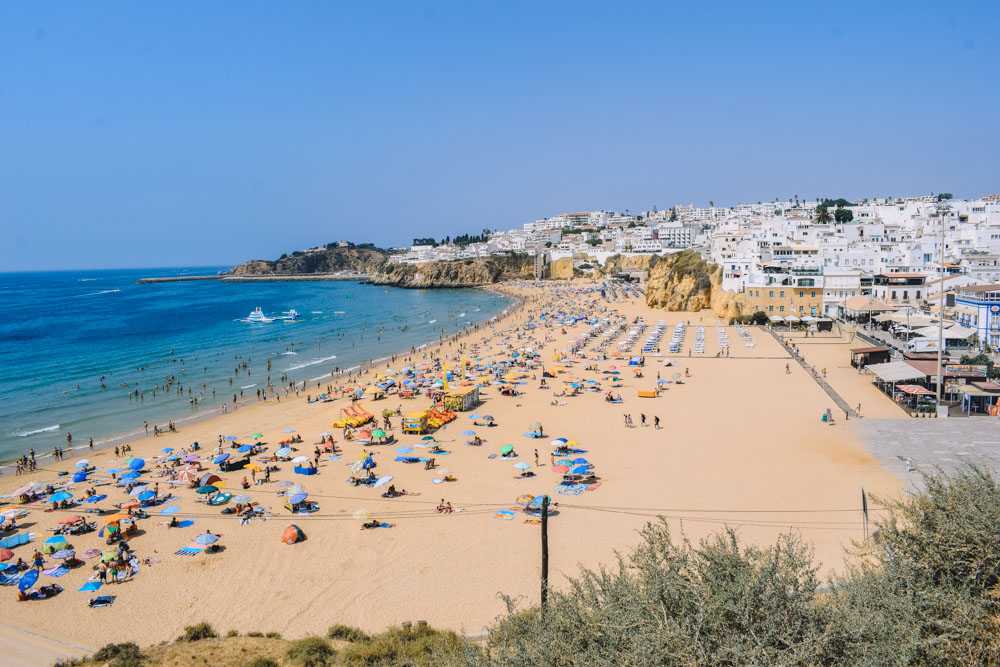
Praia dos Pescadores in front of Albufeira city centre, with Albufeira old town behind it
Where to stay in Albufeira
Deciding where to stay in the Algarve can be hard, which is why I have listed below some great places to stay in every town of this itinerary , for every budget.
Budget – Alfagar Cerro Malpique : This residence has lovely studios that are perfect for budget travellers. It’s located a bit outside the centre of Albufeira, but it has a huge pool and epic views over the sea and town.
Click here to book your stay at Alfagar Cerro Malpique!
Mid-range – Casa dos Arcos : This charming guest house is the perfect place to stay for those who want to treat themselves without breaking the bank. You can relax in their lovely courtyard after a long day of exploring the Algarve.
Check out prices and availability at Casa dos Arcos here!
Luxury – Hotel Baltum : If you want to treat yourself, this is the place to do so. This hotel has modern rooms and a huge rooftop terrace with epic views over the white houses of Albufeira and the sea.
Book your stay at Hotel Baltum here!

Exploring the streets of Albufeira Old Town
Day 2: Benagil Cave, Praia da Marinha & Lagos
This day was probably the best day of my Algarve trip. It’s a pretty tiring one, but you will be very happy by the end of it.
Sunrise kayak tour to Benagil Cave
If you’re planning an Algarve itinerary, chances are you’ve seen photos of Benagil Cave. Benagil Cave is a huge sea cave, with two entrances on the sea and a hole on the ceiling.
You can only access it by the sea, so you will have to join a kayak, boat or SUP tour to reach it.
| READ MORE: EVERYTHING YOU NEED TO KNOW ABOUT VISITING BENAGIL CAVE |
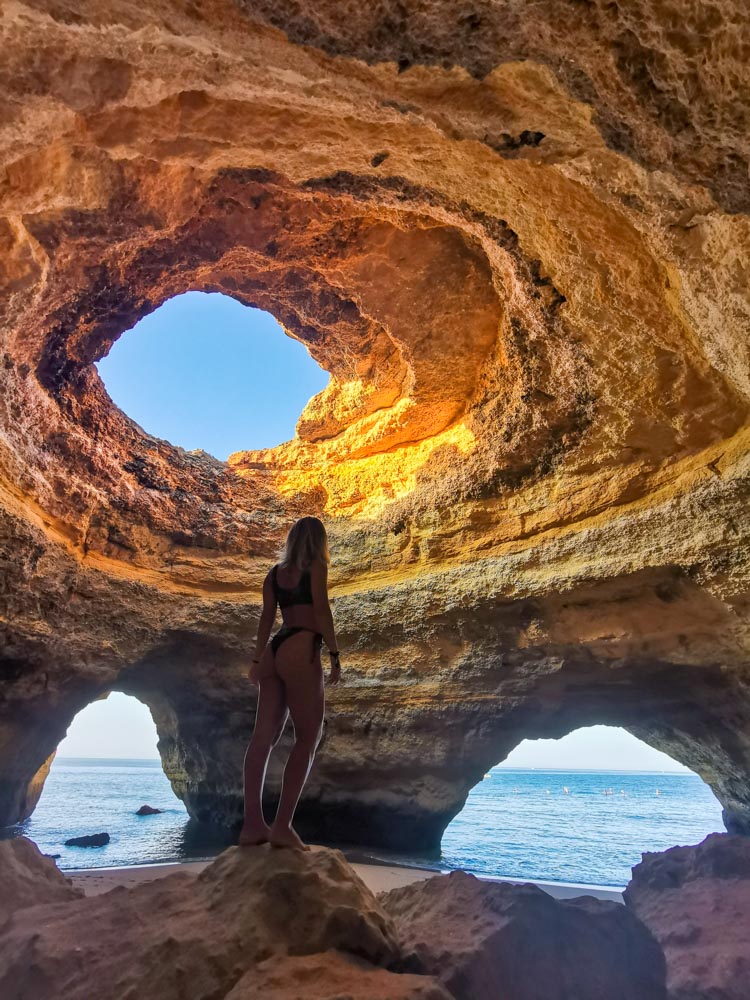
Me in Benagil Cave at 7:30AM
It’s one of the most popular stops on every Portugal itinerary, so be ready to either get up at sunrise or battle thousands of other tourists to visit it, especially in summer.
We joined a 7AM kayak tour starting from Benagil Beach and it’s the best decision we could have taken. We kayaked along the gorgeous coast of the Algarve as the sun was rising, and were the only group inside Benagil Cave.
The tour lasts around 1.5 hours, of which about half an hour is spent inside Benagil Cave, taking photos and enjoying the beauty of this natural formation. Being alone inside this sea cave is well worth the early alarm.
After that we went to three more sea caves, and kayaked all the way to Praia do Marinha, before returning to Benagil Beach, just as many other kayak, SUP and boat tours were getting ready to get in the water.
Click here to book your kayak tour to Benagil Cave , or check out prices & availability in the calendar below!
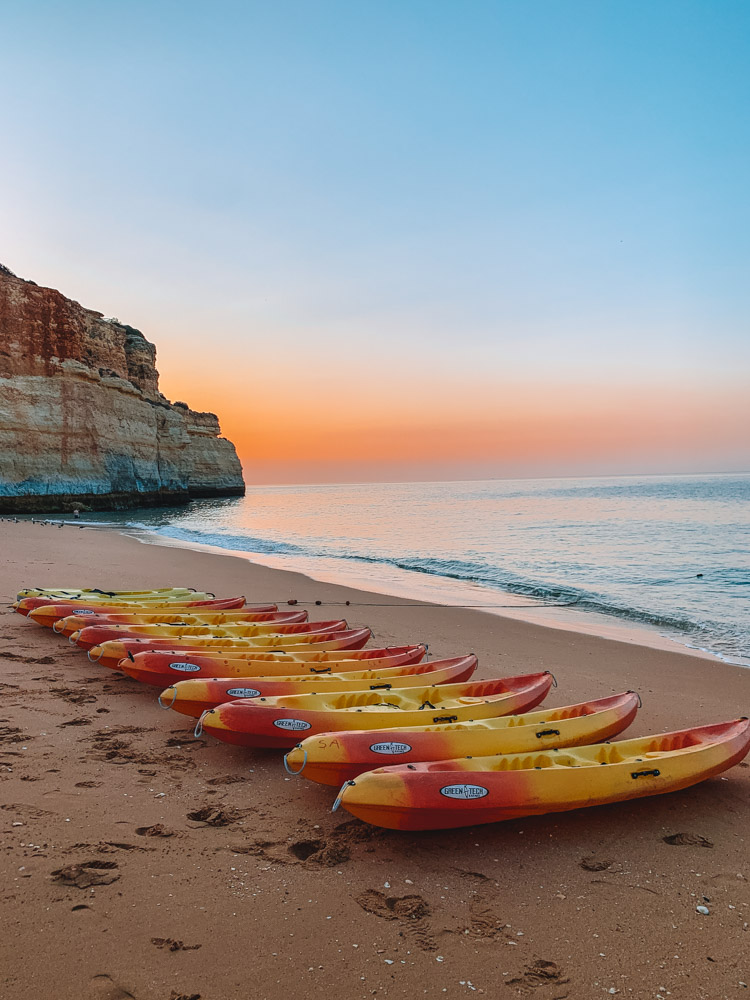
Kayaks ready for a sunrise tour to Benagil Cave
Being one of the most popular attractions in Portugal, you want to make sure you book your Benagil Cave tour beforehand. I have linked below some of the most popular tours to Benagil Cave.
Benagil Caves Kayaking Experience – This is the same tour we did, which will take you to explore Benagil Cave, other sea caves and this part of the Algarve coastline.
Benagil Caves Stand-Up Paddle Board Tour – If kayaks aren’t your thing, you can reach Benagil Cave by SUP!
From Portimao: Benagil Caves 2-Hour Speed Boat Tour – If you don’t want to paddle in a kayak or SUP (understandable if it’s 7AM) you can also join this comfortable speed boat tour.
From Albufeira: Benagil Caves & Dolphin Watching Speed Boat Tour – This tour is perfect for those who want to combine visiting Benagil Cave with a bit of dolphin spotting!

Exploring Benagil Cave in the Algarve, Portugal
Hike the Seven Hanging Valleys trail
The Seven Hanging Valleys trail is a 12km trail that starts in Praia da Marinha and runs all the way to Praia de Vale Centenaes, passing by Benagil. It’s famous for its gorgeous views over the cliffs and coastline.
We didn’t want to do the whole trail, as after we had woken up before sunrise and had already spent 1.5 hours kayaking. So we only did the part of the trail that goes from Benagil to Praia do Marinha, and takes around 40 minutes.
Along the trail you’ll walk past the hole of Benagil, so that you can peek inside the famous sea cave from above. You will also walk past some gorgeous spots like the “Heart of the Algarve” and other iconic coastline sights.
If you do the 7AM kayak tour you’ll be able to hike the Seven Hanging Valleys trail and still arrive in Praia da Marinha by around 10AM, before it gets too hot to hike and before the big crowds arrive.

Hiking the Seven Valleys Hanging trail to Praia da Marinha from Benagil

Praia da Marinha as seen from the Seven Hanging Valleys trail
Relax at Praia da Marinha
Praia da Marinha has been ranked amongst the most beautiful beaches in the world , and it’s easy to see why. This beach is characterised by fine white sand, clear emerald water and picturesque sandy cliffs up to 50m high behind it.
After your sporty morning, you can spend a few hours relaxing at this gorgeous beach, lying on the soft sand and cooling down in the crystalline water.
There is a café at the start of the beach and food trucks in the parking area above it, so you can grab food and drinks there if you didn’t want to bring them on the hike.
Being such a famous beach, you can expect loads of people to arrive in the course of the day. We stayed until around 2PM, by then the tide had come up and the beach had gotten smaller, and too many other people had arrived.
Grab some cold water and get ready to hike 40 minutes back to Benagil (and be ready to be shocked by the amount of people that will have arrived in Benagil compared to 9AM)!

Relaxing at Praia da Marinha in the Algarve, Portugal

Praia da Marinha at high tide seen from above
Do a stop in Carvoeiro
After hiking back to Benagil Beach it’s time to continue this Algarve road trip! You’ll be driving to Lagos, where you will be spending the night, but not without doing a couple of scenic stops first!
The first stop will be Carvoeiro, which is around a 15-minute drive from Benagil. This cute town is home to one of the most picturesque beaches of the Algarve.
Imagine a white sand beach with bright turquoise water, lined by tall sandy cliffs and pristine white houses perched behind it. Sounds like a postcard picture? That’s what you can expect to find in Carvoeiro.
There are two viewpoints above the beach where you can stop to enjoy the view, then maybe go for a wander in the town centre and even relax at the beach there.

Visit Ferragudo
Another stop you can do to break up your drive is Ferragudo. Ferragudo is a cute seaside town with a beautiful beach and a picturesque old town centre.
You can spend a bit of time wandering around the cobbled streets, discovering pretty white houses and flower-lined streets, and maybe stop at one of the local pastelarias for a pastel de nata!

The colourful streets of Ferragudo, Portugal

Spend the night in Lagos
By the time you arrive in Lagos you will probably by a bit knackered. Head to your hotel, take a shower, relax a bit and get ready to head out before the sun goes down!
Lagos is a town famous for its walled old town, picturesque architecture and nearby beaches.
I personally wasn’t expecting much from Lagos, I thought it was just going to be a good place to stay to explore the Algarve, but the town itself amazed me.
You can explore the cobbled streets of the old town centre, admiring the houses with azulejos facades and lively atmosphere of Lagos.
There are lots of great things to do in Lagos , as well as lots of delicious places to eat in Lagos , with many local seafood restaurants.

Exploring the old town centre of Lagos in Portugal
Where to stay in Lagos
Lagos offers a huge variety of accommodation for every budget. Here are some with excellent reviews.
Budget – Topcity Hostel & Suites : This is the hostel we stayed at for two nights and a great choice for budget travellers. They have a rooftop pool, spacious terraces for every dorm and a fun sociable atmosphere.
Click here to see prices and availability at Topcity Hostel & Suites!
Mid-range – Hotel Marina Rio : Located in the heart of Lagos, this hotel is perfectly located for your evening wanderings around town. It also has a panoramic terrace and spacious rooms, without breaking the bank.
Check out prices and availability at Hotel Marina Rio!
Luxury – Cascade Wellness Resort : This 5-star resort is perfect if you want to treat yourself. With their epic pool, garden and sea view, you can fully relax after your busy exploring days. It’s also really close to Ponta da Piedade.
Click here to book your stay at Cascade Wellness Resort!
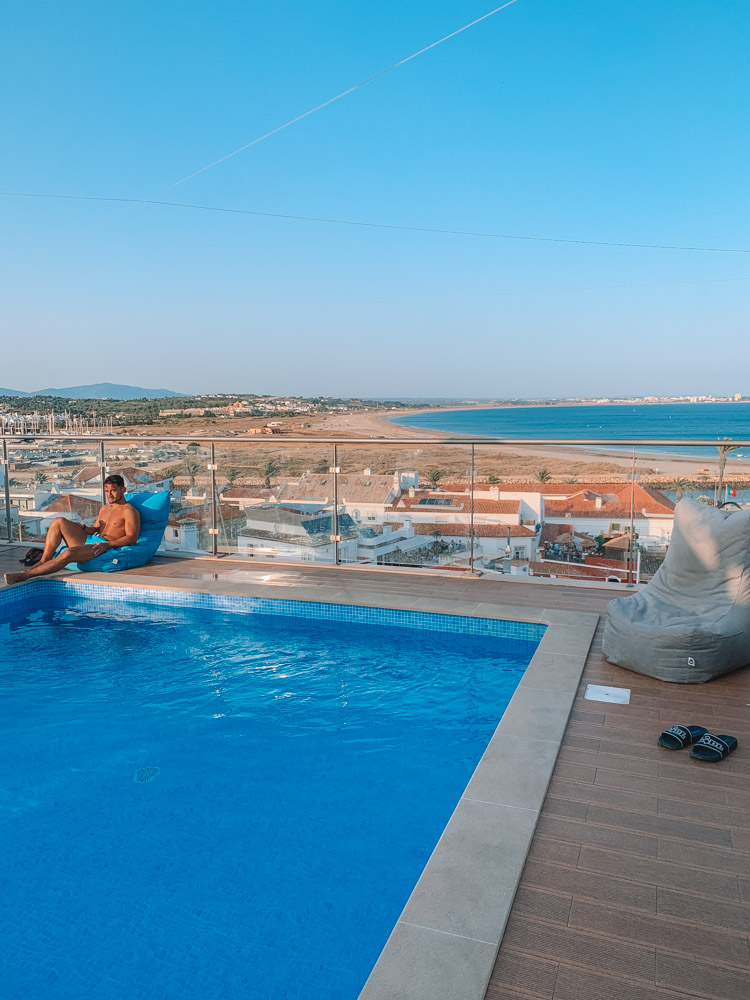
The rooftop pool at Topcity Hostel & Suites in Lagos
Day 3: Lagos Beaches & Cliffs!
Today will be a relaxing beach day with limited driving, but that doesn’t mean it won’t be rich of gorgeous cliffs and views!
The Algarve is one of the most popular winter sun destinations in Europe , and these are the beaches you can visit all year round.
Visit Praia do Camilo
If you want to make the most of this beach, I highly recommend you visit it early. We arrived around 10:30AM and there were already quite a few people there, but the big crowds didn’t arrive until 1PM.

Walking down the famous wooden stairwell of Praia do Camilo in Portugal
Praia do Camilo is one of the most famous beaches in the Algarve , and it’s easy to see why. Praia do Camilo is surrounded by tall sandy cliffs, has clear emerald water and soft golden sand.
To reach it you have to walk down the 200 steps of a wooden stairway, which add to the picturesque scenery. It’s the iconic beach you always see in photos of the Algarve.
Don’t make our mistake and put your towel too close to the sea, as the tide comes up really quickly and high, meaning you’ll have to retreat a lot.
However if by then more people arrived, there might not be much space left on the beach!
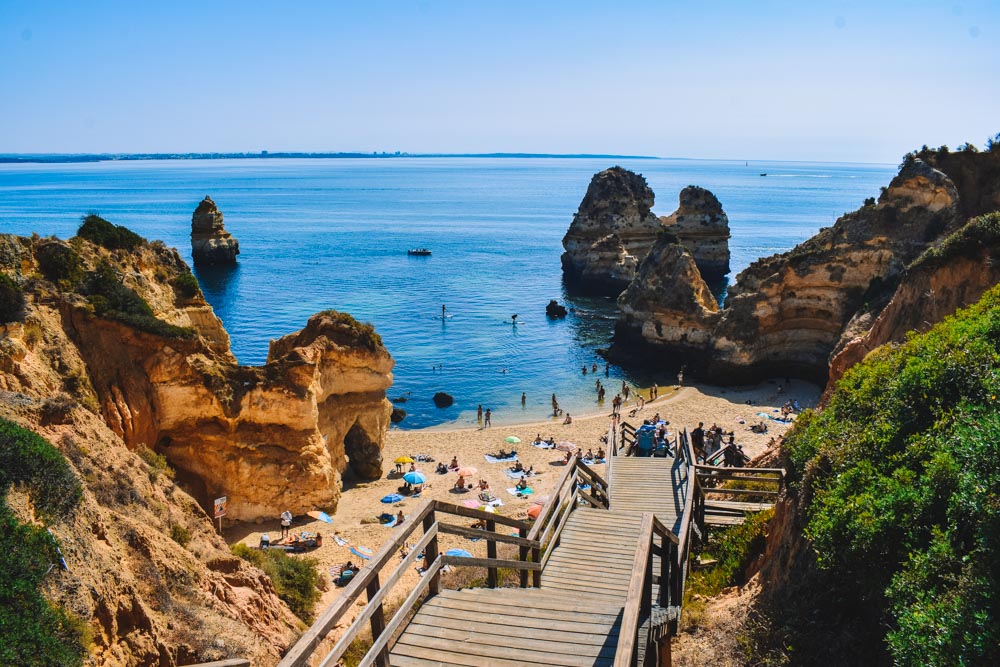
Praia do Camilo in the Algarve, Portugal
Hike along Ponta da Piedade
When the tide rose at Praia do Camilo and started splashing our towels we decided it was time to leave. We headed on foot for Ponta da Piedade, a headland famous for its stunning rock formations.
To say Ponta da Piedade left me speechless would be an understatement. We spent around an hour walking along the cliffs, and each viewpoint we stopped at amazed me more than the previous one.

The stunning views of Ponta da Piedade, Portugal

The golden cliffs and coastline of Ponta da Piedade

Enjoying the view over the cliffs and sea from Ponta da Piedade
From Ponta da Piedade you can stand at the top of these golden cliffs, looking down at the towers and arches of these unique rock formations, emerging from the crystal clear emerald sea.
It’s a sight that should feature on everyone’s Europe travel bucket list . There’s an unofficial trail all along the cliffs, so take your time wandering along the cliffs and taking in the views from every side.
From here you will also see little boats setting off for Ponta da Piedade tours. If you want to do one, I recommend you wait before doing one, more on that in the next section!

Admiring the rock formations and boats cruising at Ponta da Piedade

Relax at Praia de Dona Ana
After hiking along Ponta da Piedade you will probably want another break. You can walk down to Praia de Dona Ana, a gorgeous beach a short 15-minute walk away.
Similarly to Praia do Camilo, this beach is characterised by turquoise water, towering golden cliffs and soft white sand. Praia de Dona Ana is bigger, which means it can get busier but also that there is more space to accommodate everyone.
At Praia de Dona Ana you will also find bars, restaurants and sunbeds and umbrellas to rent. It might be less famous, but its equally beautiful and a must-see on any Algarve itinerary.

View over Praia de Dona Ana in the Algarve, Portugal
Do a boat tour to Ponta da Piedade
I know you’ve already seen Ponta da Piedade from above, but believe me when I say you will want to see it also from below.
Cruising along the base of these giant golden cliffs, winding your way below arches and through narrow cracks and inside sea caves is completely different.
If seeing these rock formations from above left me speechless, admiring them from the sea left me even more thunderstruck. From below the sea will appear even more clear and turquoise.
Click here to book your Ponta da Piedade boat tour , or check out prices & availability in the calendar below!

Cruising through the arches and sea caves of Ponta da Piedade
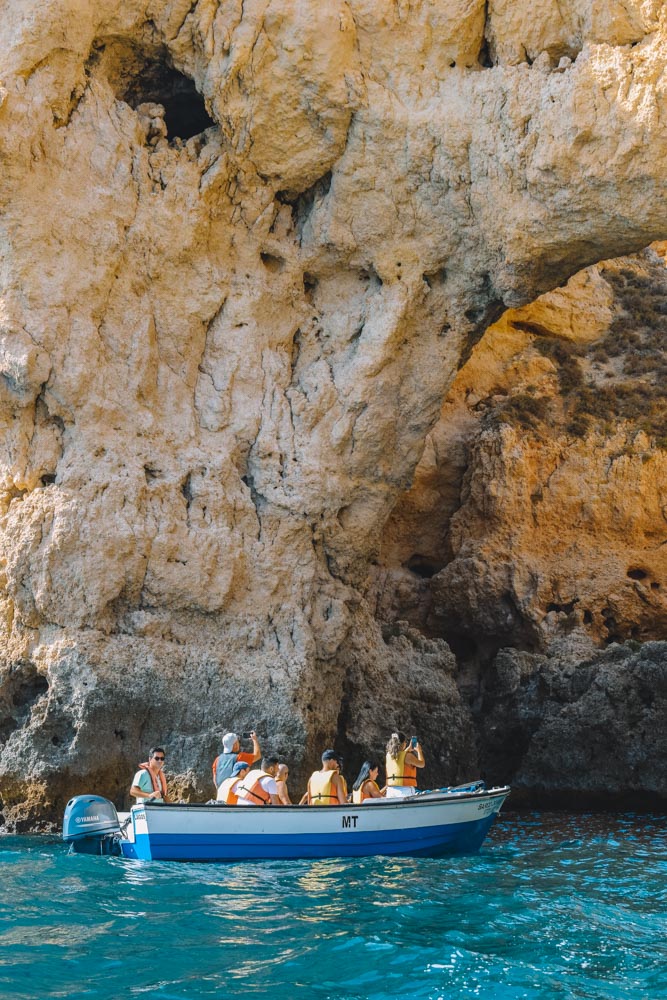
We hadn’t planned to join a boat tour, but when we saw boats setting off from Praia de Dona Ana, we couldn’t help but inquire.
The tour costs 20 EUR per person, independently from how many people you have on board, last around 45 minutes and don’t need to be reserved beforehand, just ask the stand on the beach and they’ll call you a boat.
I personally think it’s better to join a tour from Praia de Dona Dana or Lagos, as you’ll be able to enjoy more of the coastline than those starting directly in Ponta de Piedade.
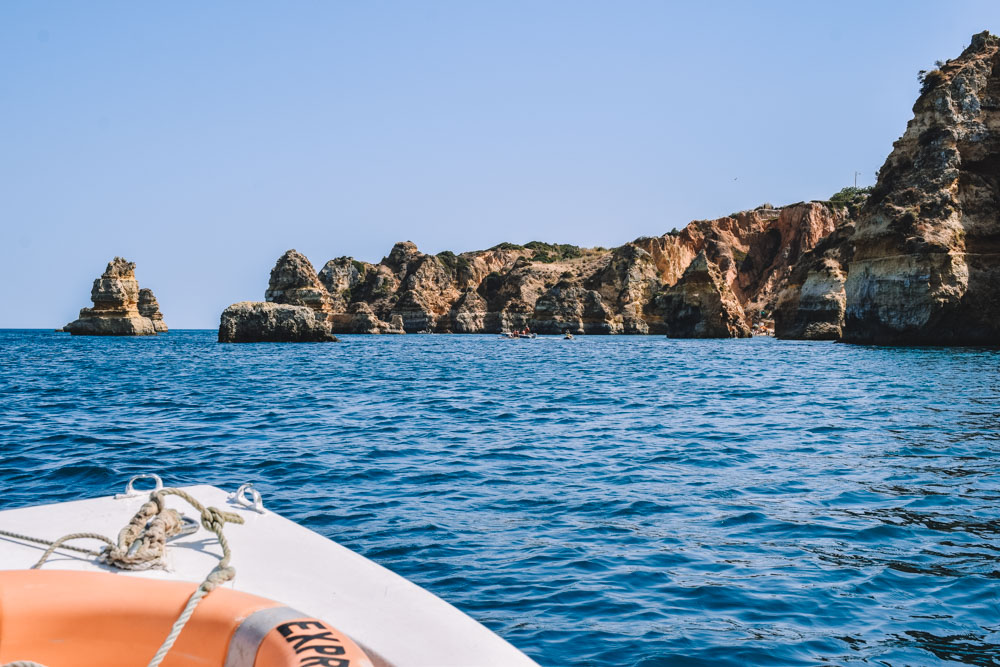
Cruising along the coast of Ponta da Piedade

Some of the gorgeous coast and beach views you can see during your Ponta da Piedade boat tour

Cruising through the rock formations of Ponta da Piedade in Portugal
If you’re visiting Portugal in high season you might not want to risk booking your tour on the beach on the day. After all, if there aren’t any available you will be missing out on a great experience!
To be sure you’ll be cruising along Ponta da Piedade, you can book online beforehand one of these popular tours.
From Lagos: 75-Minute Boat Cruise to Ponta da Piedade – This is similar to the boat cruise we did, except it starts in Lagos so you’ll be able to see more of the coastline.
From Lagos: Algarve Golden Coast 4-Hour Catamaran Cruise – This tour is much longer, since the boat you’ll be cruising with is much cooler! It wouldn’t just be a sight seeing tour, but a proper catamaran sailing experience.
Ponta da Piedade Sunset Cruise From Lagos – If you want to do something more unique, cruising this coastline at sunset and enjoying the beautiful golden light is simply magical!
From Lagos: 2-Hour Kayak Cave Explorer Tour – For the more active travellers, this tour is perfect! It will allow you to get close to these gorgeous rock formations, and really appreciate their natural beauty.

Kayaking through the arches and sea caves of Ponta da Piedade

A kayak tour in Ponta da Piedade in the Algarve, Portugal
Visit Praia dos Estudiantes
On your way back to Lagos at the end of the day you can do a stop at Praia dos Estudiantes. I didn’t personally love this beach, but there’s no denying it’s one of the most famous beaches in the Algarve and a must-see.
It’s famous because you have to walk through a rocky tunnel to reach it, and because of the Roman bridge that connects two of the cliffs that tower above it. It’s similar to other beaches in the area, but arguably more scenic.
If you visit it towards the end of the day it will be less busy, so that you can enjoy the scenic beach all to yourself.

The famous bridge of Praia dos Estudiantes in Lagos
Days 4 & 5: Sagres & surroundings
I grouped the final two days of my Algarve itinerary since, while I believe you need two days to properly enjoy this part of the Algarve, the order in which you do the activities is flexible.
The drive from Lagos to Sagres is only around 30 minutes, once there it’s time to hit some of the most famous surfing beaches in Portugal!
Surf at Praia do Telheiro, Praia do Amado or Castelejo Beach
The whole western coast of Portugal is famous for its world-class waves, but the southern region around Sagres is especially popular. Even if you don’t surf, these beaches are still spectacular and worthy of a visit.

Praia do Amado in Portugal
The main surf beaches are Castelejo Beach, Praia do Telheiro and Praia do Amado. I tried surfing at all of them, but since I was visiting Portugal in summer I got unlucky with the conditions and there were no waves.
The beaches here are much bigger than their neighbours on the southern coast of the Algarve. Here you will never have issues of space or rising tides pushing you onto the towels of other travellers.
My personal favourite was Praia do Amado. It won me over with its soft white sand, the unique cliffs behind it and the clear turquoise water. There were also two very affordable bars overlooking it.
Castelejo Beach is also very scenic, with the tall behind it and the wide beach. You can find surfing schools directly on the beaches or book your lessons online beforehand.

Castelejo Beach in Portugal

Explore Sagres Town
Sagres might not be as unique and quaint as some of the other towns in this Algarve itinerary, but it’s still worth exploring. You will find lots of unique shops, bars and restaurants.
There is a very famous ceramics shop called Artesanato a Mo. If you’ve seen photos of someone standing in front of a wall of ceramics, chances are it was the front of this shop.
We also had lovely dinner at Laundry Lounge. As the name suggests, it’s a bar and restaurant where you can also do your laundry.
It’s a bit on the higher price end, but the food and cocktails were great (and we really had to do laundry).

The colourful shop front of Artesanato a Mo in Sagres
Watch the sunset at Cabo de Sao Vicente
Along with the surfing and beaches, Cabo de Sao Vicente was one of the highlights of our time in Sagres.
Make sure to bring an extra jacket as it can get very windy, we didn’t plan for that and were freezing while watching the sunset!
Cabo de Sao Vicente is a rocky headland with steep cliffs and a lighthouse perched at the end. Here you can watch as the sun sets directly into the ocean, and turns the cliffs pink.
There are also food trucks from which you can get food and drinks to nibble on while watching the sunset. It can get very busy, so make sure to head there a bit early if you don’t want to park miles away!

The cliffs of Cabo de Sao Vincente at sunset

Enjoying the sunset at Cabo de Sao Vincente in Portugal
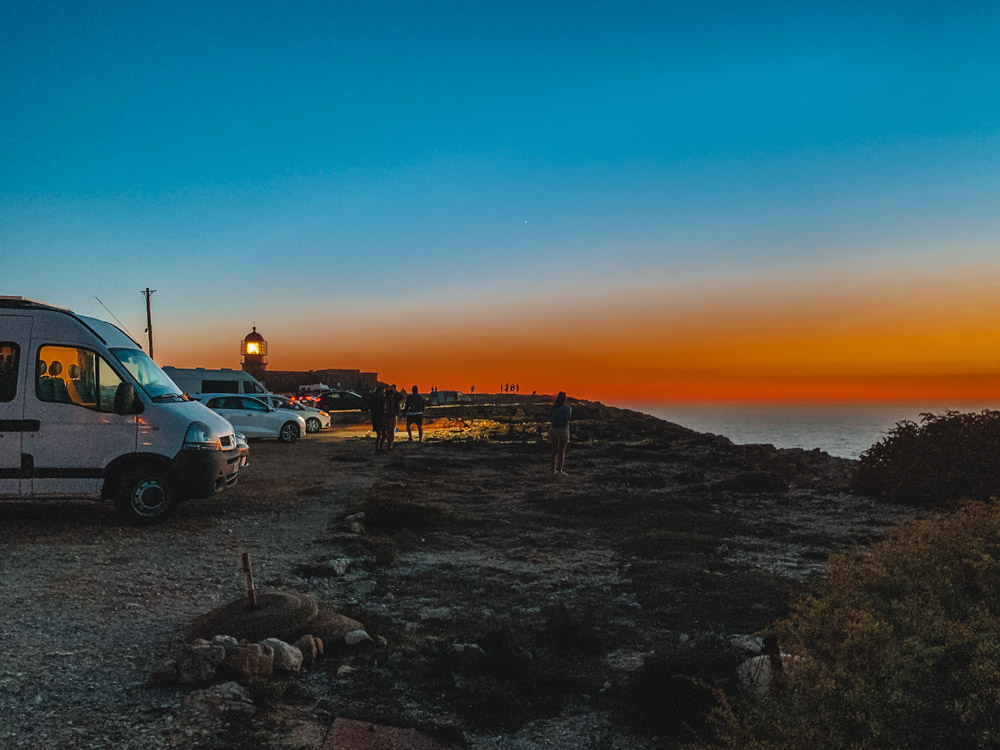
The sunset at Cabo de Sao Vincente in Portugal
Costa Vicentina
From Sagres you can then drive along the Western coast of Portugal to the Parque Natural de Sudoeste Alentejano e Costa Vicentina.
This 900km squared natural park is one of the few places where you can find wild European coast.
Here you will find long wind-beaten beaches with fine white sand, strong waves and dramatic landscapes. It’s very different from the rocky cliffs of the Algarve, but equally beautiful and much less crowded.
Being a natural park, there are restrictions in place to avoid it becoming an overdeveloped tourist destination. This wild and rugged beauty is exactly the main selling point of the Costa Vicentina.
Depending on your Portugal itinerary, you can then also drive north onwards to Lisbon , Sintra , Porto and all the other main attractions of Portugal.
If you like seaside destinations, you’re bound to enjoy Nazaré and Ericeira , whilst destinations like Obidos and Evora are best suited for history lovers who want to see cute medieval towns.
And if after moving around so much in the Algarve you don’t want to drive as much anymore, you can easily visit all these famous destinations on day trips from Lisbon and Porto (even the Douro Valley )!

Where to stay in Sagres
I found Sagres was much more expensive than other parts of the Algarve. However thanks to its surf vibe there are lots of fun hostels and surf houses. Here are some accommodation options for every budget.
Budget – The Lighthouse Hostel : We stayed here for two nights and loved it. They have dorms, private rooms and bungalows, so there’s an accommodation style for everyone. They also have a pool, a lovely garden and friendly vibe.
Click here to book your stay at The Lighthouse Hostel!
Mid-range – Casa Azul Sagres : If you’re looking for something nice that won’t break the bank, this hotel is perfect. They have both cheaper double rooms and apartments for families or those who want more space.
Book your stay at Casa Azul Sagres here!
Luxury – Mareta Beach House : If you want to treat yourself, this boutique residence is the place to do so. With their spacious rooms and infinity pool with sea views its the perfect place to relax after a long day of surfing and beaching.
Check out prices and availability at Mareta Beach House!

The pool and garden of The Lighthouse Hostel in Sagres
What to pack for your Algarve trip
Besides the usual travel essentials , there are a few things you’ll want to be sure you pack for your Algarve trip.
Waterproof bag – Whether it’s to protect your electronics during your Benagil kayak tour or your boat tour of Ponta da Piedade, a waterproof bag is always handy in these situations.
Sun protector – The sun in this part of Portugal can get very intense, make sure to stay protected!
Power bank – You don’t want your phone to die while you’re taking photos of the gorgeous Algarve or while you’re trying to Google Map your way around a new city.

Exploring Carvoeiro in the Algarve

Final thoughts on the ultimate Algarve itinerary
There you have it, the ultimate Algarve itinerary! Have you been to the Algarve before? How did you find it? Let me know in the comments below!
Visiting the Algarve had been on my travel bucket list for ages, and finally exploring this part of Portugal was a dream come true.
From the dramatic cliffs of Lagos, to the scenic Benagil sea cave and the epic surfing beaches of Sagres, you will have an unforgettable time in the Algarve.
My Algarve itinerary is based on my trip and my five days in the Algarve. You could easily spend more or less time there, but this Algarve 5-day itinerary will allow you to see all the main sights, while also having time to relax a bit.
I hope you find this article useful in planning your own Algarve itinerary! If you have any questions, just let me know in the comments below!
Looking for more Portugal travel guides? Check out my other articles!
- The ultimate Azores 10-day itinerary
- Everything you need to know about hiking in the Azores
- 10 best things to do in Sao Miguel, Azores
- 11 awesome things to do in Terceira Island, Azores
- The best whale watching tours in the Azores
Enjoyed reading my Algarve 5-day itinerary? Pin it!
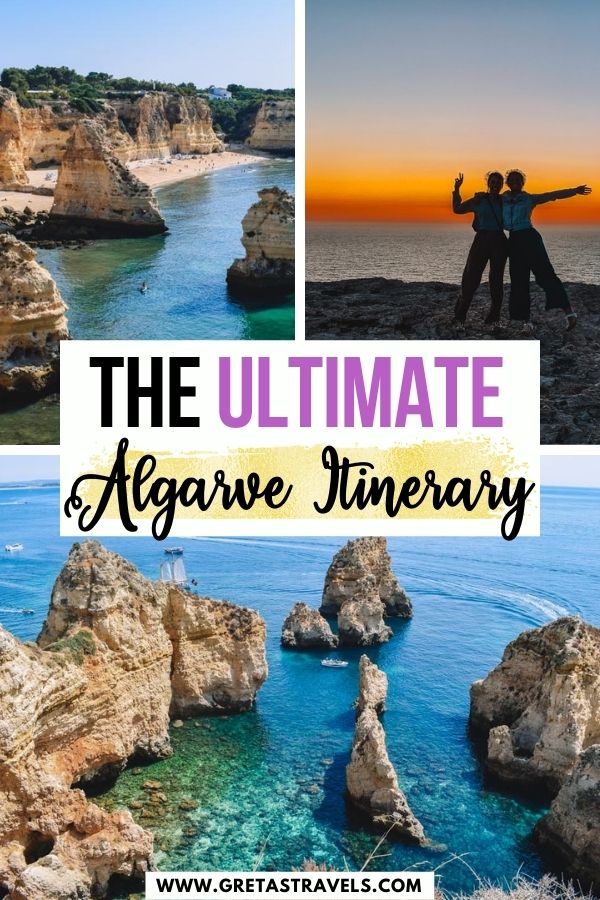
- Family holidays

- Dreaming of Sunset with Oliver’s Travels
- Best Cities in Europe for Remote Working
- 10 Wow-Factor Homes For Your 2024 Reunion Holiday
- Our Top Tour De France Luxury Villas 2023
- The Most Popular Travel-Inspired Interior Trends
- The Best Places to Take a Workation – UK and Abroad
- Oliver’s Vampire Weekender – Only the Undead Should Apply!
- www.oliverstravels.com
- Smart Travel
- Places To Stay
- Travel Guides
Algarve Travel Guide
Though most people tend to see the Algarve as all about the beaches and a holiday on the Med, there’s far much more to this sun-baked corner of Portugal. There’s actually a load of fascinating culture and history, superb cuisine and enthralling adventures to be had, though we’d be the first to admit that the beaches are pretty special too, with lots of sand and wonderfully clear water. But while you’re enjoying one of our fantastic villas in Algarve , you may well want to take some time out from all that sun worship to explore everything else the region has to offer – so we’ve put together this handy travel guide to give you a little help and inspiration!
When to visit | Hidden gems | F or families | Things to do | For foodies
Why visit the Algarve?
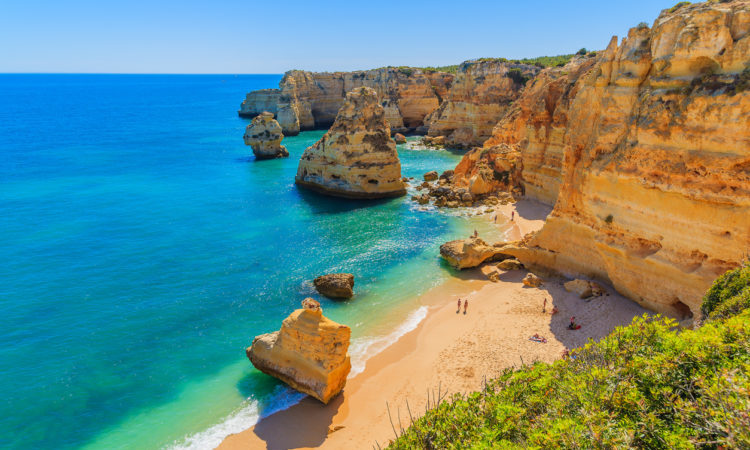
The Algarve has been on the tourist map since the ‘60s yet this beautiful and diverse region is not all heavily developed. Away from the high-rise resorts is a natural, unspoiled coastline that’s well worth writing home about – a network of wide sandy stretches and rocky coves, edged on one side by clear-as-glass water and on the other by a sweep of distinctive red-hued cliffs. Venture inland and you’ll find verdant woodland, punctuated by pretty white-walled market towns and fascinating Roman ruins. Coupled with fantastic rustic Mediterranean food and excellent local wines, the Algarve is undeniably alluring.
Our mini Algarve guide to the best sights
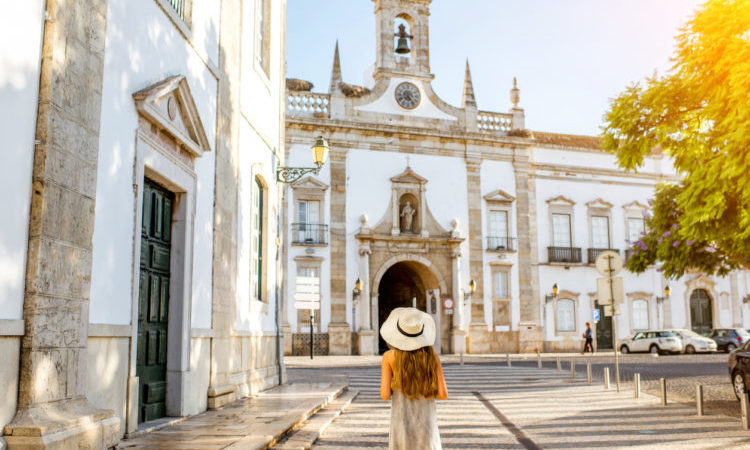
- Faro – Wander the atmospheric Old Town.
- Golf – Choose from around 35 top-of-the-range courses.
- Silves – Visit the castle at this charming Moorish town.
- Caldas de Monchique – Soak in hot springs at this thermal spa town located in the cork-forested interior.
- Praia da Arrifana – Ride the waves at this surfing mecca.
- Tavira – Traverse the Roman bridge at this elegant fishing town, west of Faro.
- Ria Formosa Natural Park – Discover an unspoilt paradise teeming with birds, flora and fauna
When to visit?
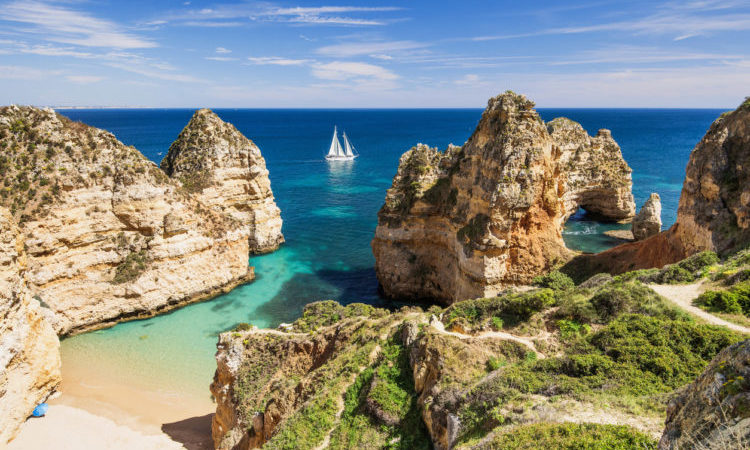
Let’s start with a statistic: the Algarve has over 300 days of sunshine a year. That sunshine can be felt even in February when temperatures sometimes allow for alfresco lunches. Dinners outside are less likely as nights can get cold at this time of year. Early spring is pretty with warm temperatures, fields of wild flowers, fragrant blossoms and fewer crowds. Come May , the sea starts warming up too.
The sun is at its strongest over the summer months of July and August , which coincides with peak tourist season. September and October tend to be much quieter, but still have some of the last straggling remnants of the summer’s heat. Most of the Algarve’s little rainfall occurs in winter .
Getting around the Algarve
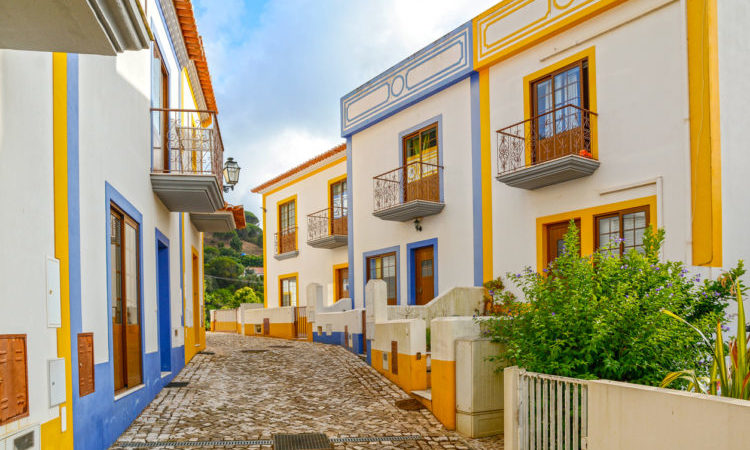
- Airport: Travel from UK to Faro Airport, the only airport in the Algarve.
- Public Transport: Two reliable bus companies, Eva Transportes and Renex , service the Algarve and also head inland too via Loulé. Trains run along the coast between Faro and Vila Real de Santo António, and between Faro and Lagos.
- By Bike: While the roads in the more built-up coastal stretches can be busy, the Algarve’s rural bike routes offer a very enjoyable, although often hilly, way to explore some of the region’s smaller villages. Guided tours are available and you can hire bikes around Albufeira and Faro.
- Taxi: Taxis in the Algarve are easy to spot: they all have a sign saying ‘taxi’ on the roof. They are available from the stands at the airport. In towns you can hail from the street, although it’s usually better to call from a hotel or restaurant when you are ready to leave.
- Car Rental: Car hire is very popular in Portugal and gives the maximum freedom. Roads are good, and many of the coastal routes boast sensational sea views, though motorways do have toll charges. Pick up a car at the airport, where Hertz , Avis and several other reliable companies, can be located.
Hidden Gems
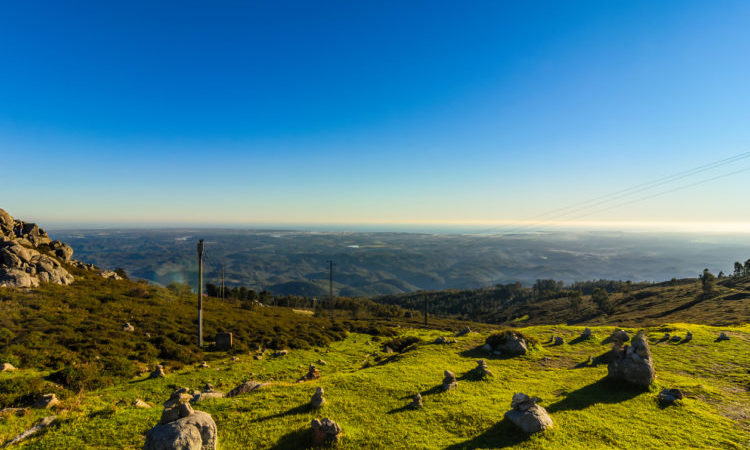
The view of Algarve from Foia, Monchique
- If you are en route to pretty Tavira, east of Faro, take a detour to discover the tiny, whitewashed village Santa Luzia . Join the locals in eating octopus at the harbour-side restaurants, and after lunch, take the vintage train to wide and lovely Barril beach on the Ilha de Tavira.
- For an off-the beaten track beach, head to Zavial . But instead of joining the sunbathing hordes here, drive onto the next headland to secret spot Ingrina . This picture-perfect cove has silky sand and an arc of turquoise water. The calm sea is great for swimming and there’s an excellent restaurant with a laid-back vibe serving daily fish specials. You could easily idle a day away in this idyllic setting.
- For sensational views that will give you a real perspective, head to the highest point in the Algarve: Foia , the summit of the magnificent Monchique mountain range. From your elevated vantage point at 900 metres, you’ll be able to look out over the lush rolling carpet of cork and pine trees, eucalyptus scrub and orange groves. On a clear day, you can even see as far as the northern mountain ranges. Be prepared for much cooler temperatures up here and a few unsightly communications towers at the summit itself.
- You may well be planning a trip to Sagres , on the southwest peninsular, as part of your holiday in the Algarve. After all, this historical village was the domicile of Prince Henry the Navigator, the 15th-century explorer and cartologer. However, not many people know that this is also one of the best places in the Algarve to catch a sunset. The stunning vista of the white fort atop the red cliffs with burnt orange sun hitting the shimmering sea behind it, could well be your most memorable holiday moment.
- Just eight kilometres east of Faro is the large fishing port of Olhao , home to one of the biggest indoor fruit, vegetable and fish markets in the Algarve. A veritable explosion of colours and smells, the market is also a fantastic opportunity to see an authentic, untouristy part of everyday life in the Algarve. The cafes that line the streets around the market a great spot to chat to locals and sample freshly cooked seafood.
Algarve travel guide for families
If you’ve come to the Algarve with your family, expect to have a jam-packed itinerary – there is a lot to occupy you and your brood here. Our selection of resorts in the Algarve are particularly family-friendly, with activities, entertainment and great facilities.
With a climate that is dependably sunny, staying steadily warm and dry from May to September, it makes sense to start in the Algarve’s great outdoors. As we all know, busy children are happy children, and in the Algarve you can cherry pick from the plethora of child-friendly outdoor pursuits.The beaches are the best place to begin: older kids can learn to surf in the baby waves, little ones can explore rock pools and budding ornithologists can bird-spot in the sand dunes. Out at sea, the family can take a boat trip to explore hidden caves and perhaps even do a bit of marine wildlife spotting – what little explorer wouldn’t want to see a dolphin on their holiday? Back on shore, tennis lessons, waterparks and treetop climbing adventures will add to the long list of amazing experiences that await your family in the Algarve.
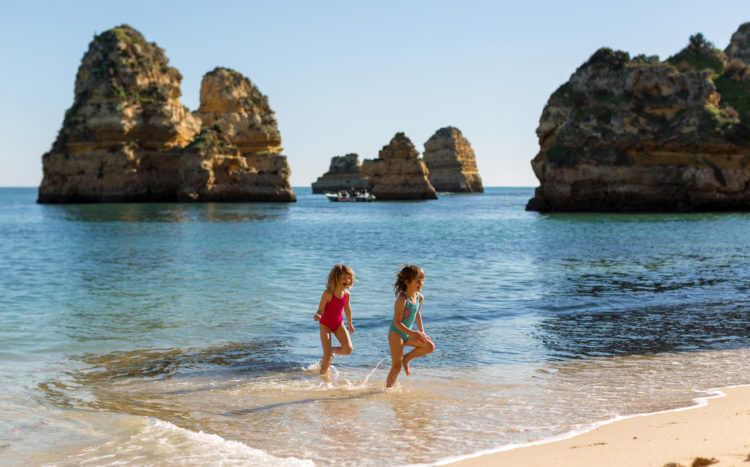
Family-friendly activities
- One of the main appeals of the Algarve is its coastline, and thanks to the fact there’s some 125 miles of it, you and the kids will have plenty of opportunity to play on the beach, as well as indulging in some slightly more exhilarating activities!
- Dream Wave Algarve offer several sorts of boat cruises around the Algarve’s coast, but the kids are bound to be utterly spellbound by the one that takes place on a pirate-themed sailing vessel.
- Older kids might be more tempted by the challenges at Albufeira Surf and SUP . Everyone can try their hand at surfing, and stand-up paddleboarding is an easy and low-impact water-sport if you’re feeling a little less energetic.
- Also heading out from Albufeira is Dolphin Driven , which can take you out on an exciting (and ecologically responsible) excursion to see some dolphins in the wild.
If this guide is going to prove anything, it’s that heading in the opposite way to the sea is a great way to keep everyone entertained too! The Algarve’s beautiful interior doesn’t just provide some beautiful landscapes to hike or bike around – there’s some serious fun to be had too.
- Top of the list must be Parque Aventura , which will bring the family together in a whole new way as you traverse a challenging treetop tour on bridges and ropes – and children as young as four are welcome on the easiest routes.
- Sport-mad kids might enjoy a few games at the Valo do Lobo Tennis Academy , where they can sharpen their game and make new friends at the same time. Better yet, there’s leisure facilities that parents can enjoy while the kids improve their serve!
If these fantastic tips have got you inspired, be sure to take a look at our incredible list of the best family activities in the Algarve .
Family-friendly beaches
- Ingrina can be found near the village of Raposeira, and its gentle and shallow waters are great for smaller children. Older kids can enjoy exploring the rocks that surround the beach, and there’s a nearby restaurant to make sure everyone’s fed and watered.
- Meia Praia near Lagos is a bit more lively, and you’ll find a huge range of beachgoers enjoying the atmosphere no matter when you turn up. There’s plenty to do and plenty of places to eat, so it’s a good choice if you’re looking for a more active day over relaxing.
- Galé Beach is fairly central and can also get quite busy, but the rock pools are great for adventurous little ones.
Things to do in the Algarve on group holidays
Taking a holiday with a group of friends is one of the best kinds of breaks: long days leave plenty of quality time for catch-ups and chats. But getting the balance between lazy days and fun activities takes a little planning. The beauty of the Algarve is that there’s a fantastic range of activities to keep everyone happy, from surfing to cycling, as well as a sun-drenched climate that makes it possible to enjoy getting out and about all year round.
You might canoe on the sparkling turquoise waters of the Atlantic one day then try a spot of wine tasting the next. Add a bicycle tour of whitewashed Moorish villages, a dolphin safari on your own private charter and a bout of bird-spotting in a lush nature park onto the agenda, and you’ve got yourself a truly memorable holiday your friends will be raving about for some time. Take a look at our fun-filled ideas and start planning your group holiday.
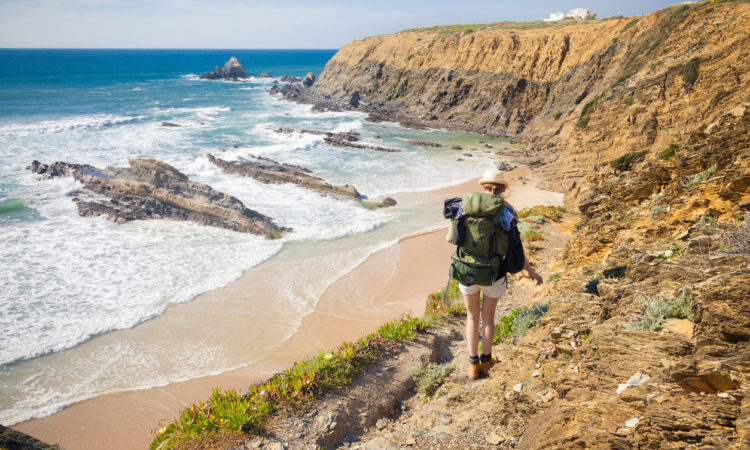
Adrenaline-fuelled activities
- The further inland you go in the Algarve, the more of the region’s landscape you’ll get to see. Rocky outcrops and groves of orange trees vie for space, creating a land of stark contrast and beautiful colours. There’s many ways to see it, from day-long hikes to bike rides, or you could always rent some snazzy wheels for that extra touch of glamour.
- Bike My Side is a great alternative to the average tour – you’ll be whisked around the countryside in a motorbike side car!
- If you’re looking to cycle, Bike A Wish can not only provide you with bikes to hire but can also take you on guided tours tailored to your tastes – you can visit historical sites, local landmarks or even sneak in some horse riding as part of your trip.
- Something a bit different (but perhaps slightly less hair raising) is to see the Algrave by Segway – you can rent one through Algarve by Segway .
- Taking advantage of the Algarve’s expansive coast is a must if you and your friends fancy some high-octane activities. There’s a huge amount on offer including diving, sea fishing, windsurfing and more.
- Or why not hire a boat through Southwest Charter ? The skipper will do all the hard work, but you can kick back in the stern or enjoy the thrills of life at sea at your leisure.
We have more inspiration when it comes to things to do, why not read our top 7 things to do in the Algarve .
Laid-back activities
- If you’re up for broadening your cultural horizons a little bit and feel like experiencing some of the more sophisticated things to do in the Algarve, there’s a surprising amount of museums and churches just ripe for exploration. You might have to head out of the more developed towns and cities to find them, but that’s all part of the fun!
- An interesting day trip can be found at Novacortica , a factory that showcases one of Portugal’s premiere products – cork. You’ll be shown around the floor and given an introduction into the production of cork, as well as an insight into a fascinating local industry.
- Natura Algarve runs tours that explore the swamps and wetlands – and they even provide you with your own set of binoculars, as well as stopping on the picturesque island of Cultura for a spot of lunch. As well as the more famous port, Portugal’s wine scene is burgeoning. As a result, you won’t just be able to enjoy a tasty tipple with your dinner, but you can visit a number of wineries and vineyards for some top-notch tasting.
- Quinta dos Vales produces some of the Algarve’s best wines, and as well as the tasting tours available, the estate maintains a beautiful flower garden that contains numerous artworks and sculptures by local artists.
- The coastline of the Algarve isn’t all sandy beaches – there are some beautiful wetlands off the coast of the city of Faro that’s home to some wonderful birds and wildlife – so grab your binoculars or head on a boat tour to explore the other side of Portugal’s coastal landscape.
A foodie’s guide to the Algarve
Whether it’s a casual feet-in-the-sand beach café, a bustling market-side restaurant or a rustic hilltop eatery, dining out in the Algarve will mean sampling the fantastic Algarvian produce – all sourced from the sea, the forested hills and fruit-filled groves. Seafood understandably plays a big part in the menu of almost every establishment: octopus, squid, sardine, bream and lobster are in abundance, whilst Iberico pork, sheep’s cheese and black pudding are also big in the region. If you want to indulge in some haute cuisine on your holiday, the Algarve has some fantastic Michelin-starred restaurants delivering impressive and innovative creations. Fortuitously, the Algarve wines happen to pair quite happily with the high-quality Algarvian ingredients. The fertile soil and fine climate of the Algarve is ideal for growing grapes and though it can’t claim the cachet of Douro, for instance, its burgeoning wine industry is producing some superb reds. Here are some of our suggestions for experiencing the best of the Algarve’s food and wine.
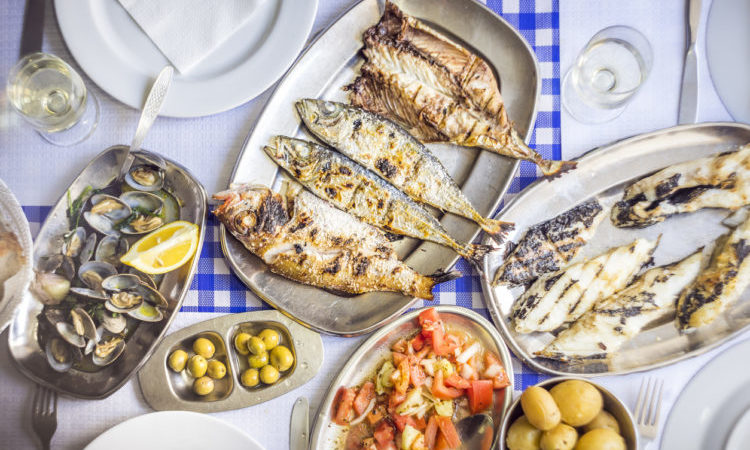
Best restaurants
- You can enjoy some of the finest dining on the Algarve at the Ocean Restaurant in Alporchinhos. Boasting two Michelin stars, the name might give you a bit of a clue as to what kind of food is on offer, but the sumptuous preparation and indulgent menus are something that’s really worth savouring.
- Sao Gabriel in Quinta do Lago can also lay claim to a Michelin star, but don’t expect super-chic surroundings. The restaurant enjoys a cosier, more rustic feel, so it’s great for intimate dinners where the food is just as spellbinding as the ambiance.
- For something a little less formal but just as impressive, try the beachside eats available at Ferragudo’s Restaurante Rei das Praias . With sumptuous and relaxed decor, wonderful views and the freshest of seafood on the menu, it’s a relaxing and totally unique experience – and you can even get a massage if you need to relax just a little bit more!
Must-try dishes
- A dish that sums up everything that’s wonderful about cuisine in the Algarve is the cataplana – seafood in a delicate, savoury broth served in a hinged copper pot. They’re usually made to share, so grab a friend and order up.
- There’s also the famous Portuguese piri piri chicken to try – trust us, it leaves Nando’s in the dust.
- Another meaty treat is Ibérico pork , which comes from the highly prized Black Iberian breed of pig. It makes fantastic ham, but you’ll also see it on menus grilled with a range of sides.
- You can get some amazingly fresh seafood on the Algarve, and while it’s worth trying a range of what’s on offer, a trip to the region isn’t complete without a plate of grilled sardines . Simple, delicious and utterly unforgettable.
- And for dessert (or as a little pick-me-up with a nice cup of coffee) you’ll find pastel de nata sold pretty much everywhere. This small custard tart is a national treasure in Portugal, and if you’re really lucky you can grab them warm and freshly-baked.
For more delectable suggestions, take a look at our blog on the best foodie experiences in Algarve .
That brings our jam-packed Algarve travel guide to an end – we hope you’ve found plenty of information, handy tips and places to visit to add to your upcoming itinerary! If you’re still looking for a place to stay, have a look at our collection of stylish Algarve villas – some with pools, some near the beach and others just a short walk to a local village! If you need some help or have any questions, our concierge team are on-hand!

3 Responses
The Benagil cave is one of the most amazing things I saw whilst in the Algarve along with the Praia Da Marinha beach!
Thanks for guiding about the Iberian world and its mesmerizing landscape. Therefore, gear up for an excellent vacation to this part of the world. We are planning a vacation in September, it will be very helpful for us.
[…] ended up driving to Tavira, a small town on the Algarve coast. This town has several famous beaches and is home to many historical sites. Like other parts of […]
Leave a Reply Cancel Reply
Your email address will not be published.
The best time to visit the Algarve, Portugal's golden coast

Jul 4, 2023 • 5 min read
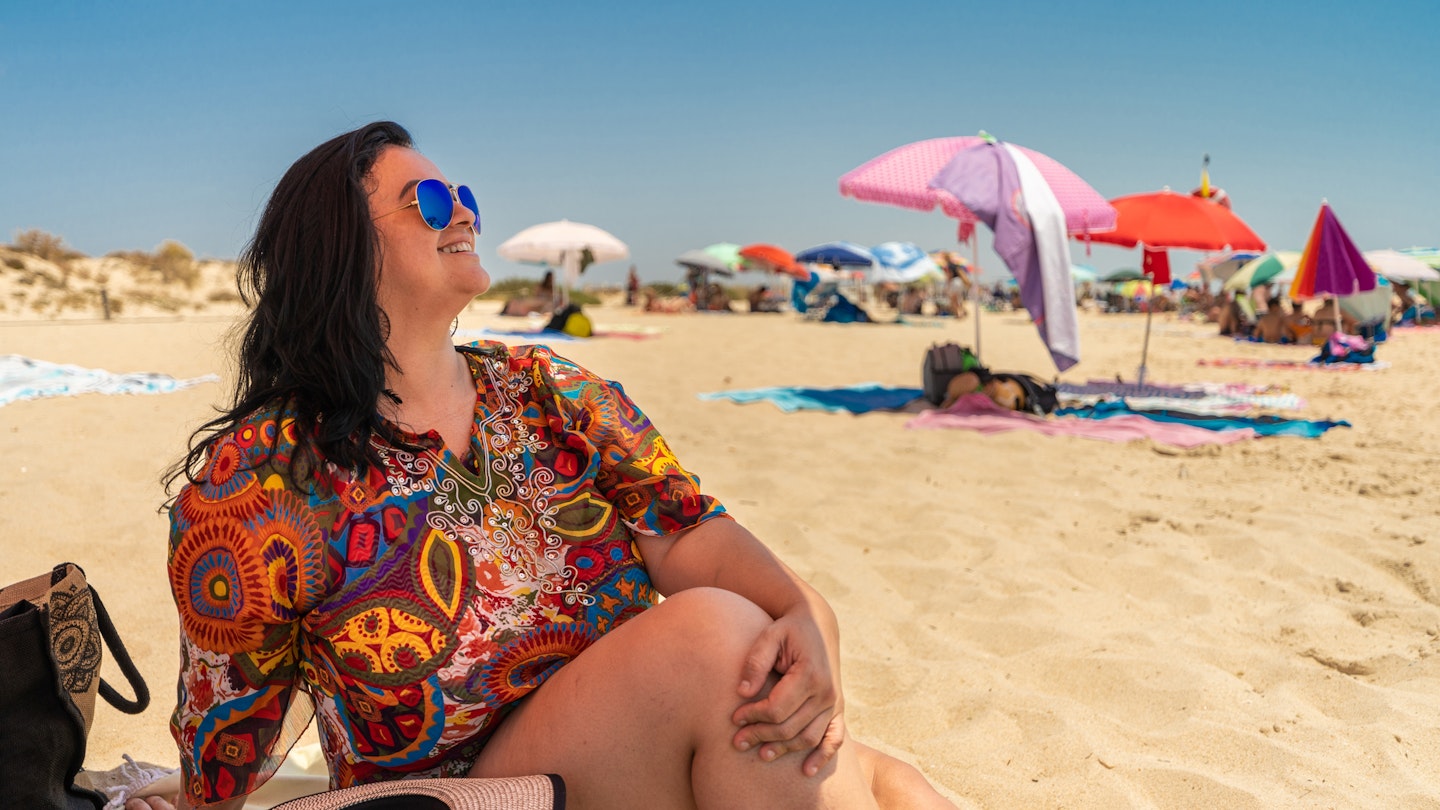
There's no bad time to visit the Algarve – it mainly depends on how you feel about crowds © Pollyana Ventura / Getty Images
The golden, cliff-backed beaches of the Algarve rank among the loveliest stretches of sand in Europe. Given the region’s obvious natural beauty – plus the great surfing, kayaking and other aquatic activities – it’s no surprise that southern Portugal draws big crowds.
Although temperatures vary from month to month, the Algarve gets reliable sunshine 300 days a year. Summertime sees the biggest influx of visitors, while winter feels like an entirely local affair, but there are plenty of activities happening no matter when you visit.
Until recently, many resort towns in the Algarve virtually closed up for the winter, with limited options for lodging, dining and organized tours. That has changed in the last few years as the Algarve’s tourism authority has begun promoting the region as a year-round destination.
Nevertheless, some places still close for the season, so keep that in mind when making your plans. Here's our guide to the best times to come to the Algarve.
June to August is the best time for perfect weather
The Algarve sizzles during high season, encouraging days of lounging on the beach followed by refreshing dips in the ocean (cold Atlantic currents mean that the sea never gets quite as warm as it does in the Mediterranean). There’s also very little rainfall and skies are virtually cloud-free during the summer peak. Festival season kicks off in June and the whole region joins the party at events like Festival MED in Loulé.
In July and August – the Algarve’s hottest months – the average temperature is around 28°C (82°F), though some days can get as hot as 40°C (104°F). With cool ocean breezes, evening temperatures hover around 22°C (72°F) – perfect for comfortable outdoor dining. Music festivals on the beach bring a surge of visitors in July with Afro Nation Portugal bringing the party to Portimão and the incredible spectacle of a candlelit culture festival is not to be missed at Mercado de Culturas à Luz das Velas in Lagoa.
The high August temperatures make it a perfect time to take a dip in the cool Atlantic waters. It's also a great month to spot dolphins on a boat excursion. Portimão street food fest and Olhão seafood festival offer the chance to mingle with locals and experience some of the delicious local cuisines on offer.
Naturally, the peak season for tourism coincides with these inviting conditions on the beach. Hotel prices are at their highest and the crowds hit their peak. If you plan to travel at this time, you’ll need to plan well in advance. Expect to pay a premium to secure your top choices when it comes to accommodations. You’ll also have to share those pretty sands with plenty of other travelers – though you can still find quieter beaches if you travel away from busy tourist centers such as Albufeira and Lagos .
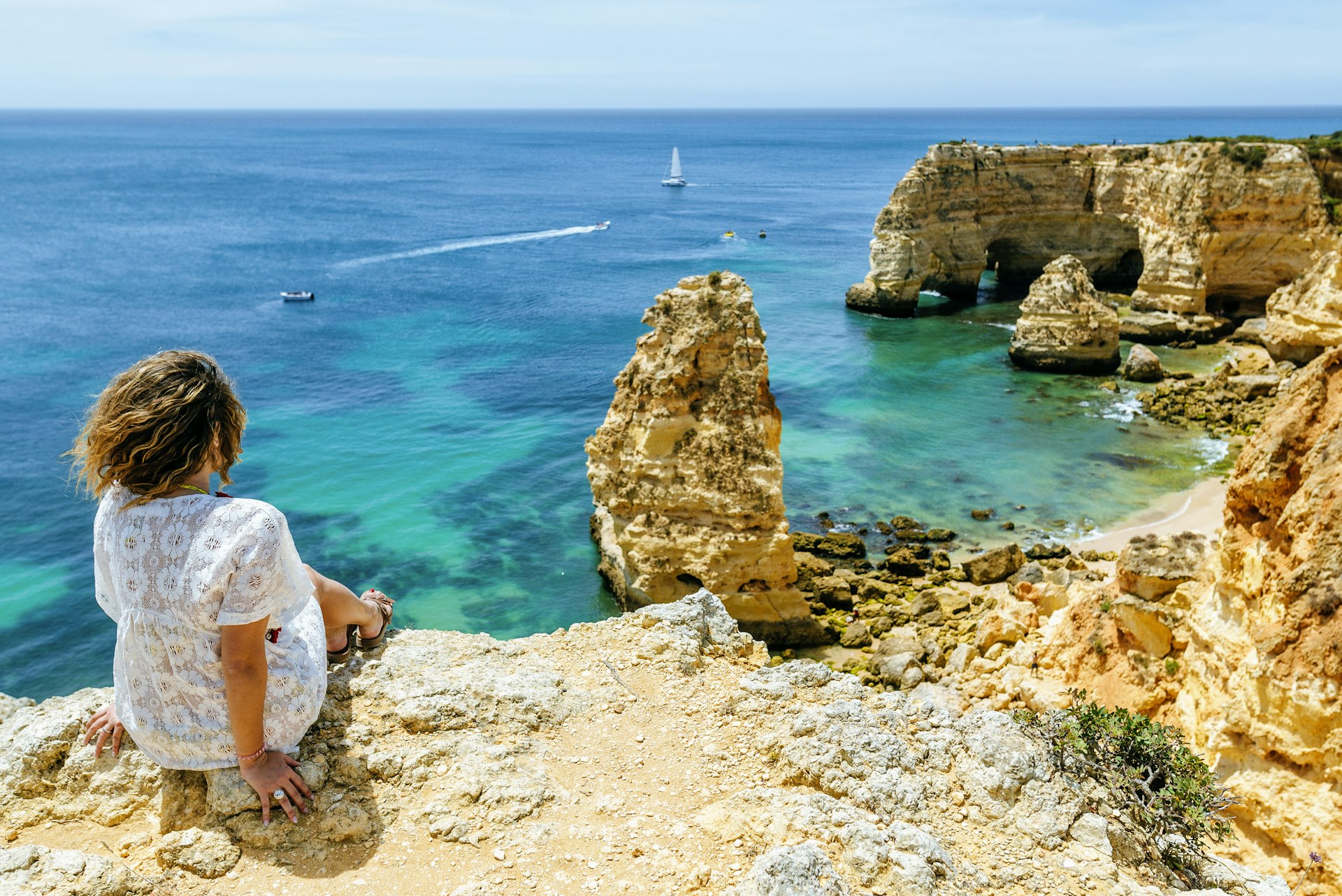
April to May and September to October are the times to enjoy outdoor adventures
The spring months from April to May and the autumn months from mid-September to October are the best times to visit if you’re interested in hiking, horseback riding, mountain biking and other land-based activities. The days are still warm and sunny, though there's a small chance of sparse drizzle, and the temperatures rarely get so hot as to be uncomfortable. Easter in April typically marks the end of the off-season in the Algarve, with the first signs of life emerging in the region's slumbering seaside towns. Easter processions add excitement, as does Liberation Day (April 25) when you can see fireworks and parades in some towns.
Whether you're heading off on a long trek such as the 300km (186-mile) Via Algarviana , or simply going for a seaside walk in the afternoon, the sunny, rain-free month of May is a great time to be out and about. Day parties and dance workshops come to Albufeira during the Kizomba Open Summer Festival – don't miss the opportunity to dance until dawn with an impressive roster of international artists.
Water temperatures in September aren’t much different from water temperatures in August, but cooler air temperatures make for pleasant beach days. You'll see fewer crowds than during the previous month. Practice your best strut beneath the sun at the Flamenco Festival in Lagos. Birdwatchers flock to the Algarve in October to see winged beauties passing through en route to Africa during the annual autumn migration. This is also a great month for outdoor activities , as you’ll get a welcome break from the summer heat.
You’ll find noticeably fewer crowds during these shoulder seasons, and you can save as much as 30% on lodging rates compared to the high season. April and May are also good months to see wildflowers dotting the hillsides, fields and coastal areas of the Algarve.

November to March is the best time for visiting on a budget
The Algarve feels like a different place if you travel in the off-season. You’ll see far fewer crowds and hear much more Portuguese spoken everywhere you go. Temperatures drop, but the days are still quite pleasant, with average highs of around 16°C (61°F), even during the coldest weeks in January and February. Even though most of the Algarve’s annual rainfall comes during the winter, the showers tend to be short, and you’ll likely see a fair number of sunny days.
As the days grow shorter in December, you’ll face brisk nighttime temperatures but lovely mild days, with highs around 17°C (62°F). In the buildup to Christmas, many towns have special markets and put out life-size nativity scenes (Vila Real de Santo António has one of Portugal’s biggest tableaus). There’s a lot happening on the Algarve’s cultural calendar in January, with art exhibitions, dance and theater performances and special winter film screenings. Faro , Portimão , Lagos, Loulé and Albufeira have the most going on, along with Tavira and Silves .
On chilly February nights, locals head inside to catch live music and dance performances in key cities. With the general absence of tourists, days are fairly quiet at seaside towns, except during the Carnaval celebrations, which see parades and revelry in the streets. The early days of spring in March bring longer days and the first blooms to the hillsides around the region. With pleasant temperatures, March is ideal for long walks without crowds.
In all, low season in the Algarve is still a great time to be outdoors, though picture yourself taking long walks on the seaside (with a light jacket handy) rather than swimming in the ocean.
This article was first published Jun 3, 2022 and updated Jul 4, 2023.
Explore related stories
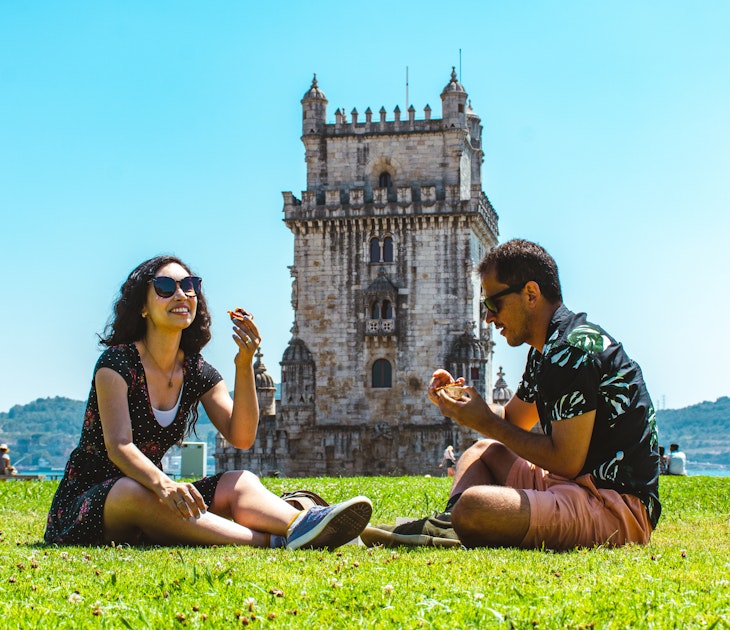
Festivals & Events
Feb 27, 2024 • 3 min read
The Portuguese capital is stunning in summer, balmy in spring and fall, and calm in winter. Read on for a detailed guide as you consider your own trip.

May 27, 2024 • 6 min read

May 17, 2024 • 6 min read
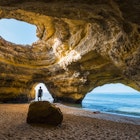
Mar 3, 2024 • 6 min read
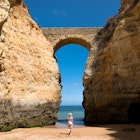
Feb 27, 2024 • 6 min read

Feb 25, 2024 • 7 min read

Feb 23, 2024 • 6 min read

Jan 26, 2024 • 6 min read
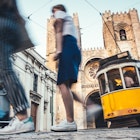
Jan 22, 2024 • 7 min read

Jan 19, 2024 • 11 min read
- Carvoeiro | Portugal
- +351 969 087 740
- 24/7 Service

Private Algarve Transfer
Make your online reservation, algarve transfers.
Algarve airport transfers available here. We offer quality and reliable transfers to all major destinations. Call today or get a quote online.
Safety First
Experienced staff and professionally trained Drivers at algarve transfers. Covid Safe.
Reasonable Rates
We can offer you the right vehicle at the right price to fit your budget, no hidden fees.
Largest Fleet
We offer an extensive fleet of vehicles including sedans, minivans and high-end vehicles.
Reliable Service
Reliable On-time Service and instant booking

Private Algarve Transfers is were we shine.
Since 2017 we have safely transported more than 2000 satisfied customers to their holiday destination in the Algarve via algarve transfers . From Faro to Sagres and beyond, to anyplace, there’s is no limit.
- Highly Experienced Staff
- 24/7 Full-Service Transportation
- Longstanding Safety Record
- No Hidden Fees – Motorway Included
- Baby Seats & Boosters Free of charge
- Newest Fleet
Algarve Transfers From The Faro Airport to Anywhere!
Expect the best.
By offering exceptional service at algarve travels with no detail unattended, we have been fortunate enough to have developed into the leading provider of ground transportation in the area.
Travel in Comfort
At algarve transfers we pride ourselves in delivering quality services to fulfill all of your needs with first rate customer care. Our goal is to make your travels safe, effortless and on schedule.

See what our Algarve transfers customers say about us!
I invite you to try our service and I personally guarantee you will have a fully satisfied experience.
YOUR NEXT TRAVEL WITH US?
Use our online tool to calculate the total cost of your ride
BOOK NOW : +351 969 087 740
Travel.in Algarve has provided reliable transfer services in Algarve area since 2018. Our main goal is Customers satisfaction.
OUR CONTACTS
- *Mobile Nacional Prices applies
- [email protected]
- Always Online
Useful Links
- Terms & Conditions
- Complaints Book
- Privacy Policy
Copyright 2022 @ 515895067 - Revivalkingdom Unip. Lda

The 12 best things to do in the Algarve
T he temptation when visiting the Algarve , particularly in summer, is to flop on the beach and switch off, but for those who want to get under the skin of the region a little bit of exploration will bring its rewards. Dip into the cool of an ancient white-washed church where statues are richly clothed and hand-painted blue and white tiles traditionally decorate the interiors. Visit a fish market to jostle with the locals in the midst of the noisy vendors over cuttlefish and octopus, sea bass and sea bream, and take to the high ground where along flower-strewn cliff edges, battered by the sea breeze, you can fill your lungs and clear your head.
For further Algarve inspiration, see our guides to the city's best hotels , restaurants , drives , nightlife and beaches .
Explore a Medieval town with strong Moorish influences
Silves was the centre of culture during the Moorish occupation of the Algarve and lies inland, surrounded by orange groves and dominated by a red sandstone castle. Visit the castle and its Cistern of the Enchanted Moorish Girl before heading to the neighbouring cathedral; dating from the 13th century, it is one of the main Gothic monuments of the region.
Insider tip: Before you leave Silves, go down to the river to see the old Roman Bridge. This was actually reconstructed in the 14th century, but its five perfectly formed arches spanning the River Arade are a work of art.
Prices: Free
Take the walking path less travelled
Via Algarviana, a 186-mile walking route, runs from Alcoutim, near the Spanish border, right across the interior of the Algarve to Cape St Vincent in the far west. It is well marked with signs indicating points of interest and nearby settlements. The route takes you well off the beaten track and supposedly was walked for the first time in the 4th century AD.
Insider tip: The best time to do this walk is in April, when the springs and streams are flowing, and the lavender and wild orchids, cistus and peonies, wild lilies and oleander, bougainvillea and buttercups are blossoming, creating a colourful patchwork to traverse through.
Contact: viaalgarviana.org
Stroll through a fabulous fish market
Nothing gives a sense of place better than a food market, and in the Algarve that means fish. Olhão, on the eastern Algarve, famous for fishing since the Middle Ages, has a wonderful market with an abundance of stalls inside selling robalo (sea bass), octopus and squid, as well as clams, percebes (gooseneck barnacles), and lagosta (rock lobster).
Insider tip: When you have finished admiring the raw fish, cross the road to try the cooked ones at the excellent little restaurant Terra i Mar , which serves crunchy weaver fish and cuttlefish eggs and the more ordinary sea bass and sea bream.
Address: Avenida 5 de Outubro, Olhão
Contact: 00 351 289 707 298
Opening times: Mon-Sat, 7am-1pm; limited produce on Mon
Play a round of golf on a world-famous course
Renowned for its golf courses, the Algarve has a huge range. The Sir Henry Cotton Championship course (18 holes, par 73) at Penina Hotel & Golf Resort , the first course built in the region, remains extremely popular and has two notorious holes – the dogleg fifth, with its canal and lake, and the 13th, shadowed by water from tee to green.
Insider tip: Green fees vary between courses so it is worth shopping around to find the best deal. Penina is the only resort in the Algarve to offer three golf courses with an academy course and resort course alongside their championship course.
Contact: penina.com
Prices: £££
Go blue-tile spotting at an ancient church
The simple, whitewashed churches that dot the Algarve landscape give no indication of the riches that lie within. Often clad in ancient azulejos (hand-painted tiles), many also have opulent gilded altars. Doors and windows are frequently Manueline, a style of late-Gothic architecture named after King Manueline (1495 to 1521) and funded by the vast wealth brought to Portugal from the spice trade.
Insider tip: Just outside Almancil is the tiny, 18th-century São Lourenço Church, considered a jewel of the Algarve. The blue and white azulejos, finished in 1730, cover the interiors to such striking effect that the richly gilded altar is completely overpowered.
Address: Rua da Igreja, São Lourenço
Contact: 00 351 289 395451
Opening times: Mon-Sat, 10am-1.30pm, 2.30pm-5.30pm
Take to the water on a 'seafari'
Algarve Seafaris offer a variety of programmes, including deep-sea fishing, reef fishing and cruises along the coastline, exploring the many limestone caves and secluded beaches. The choice of transport ranges from large catamarans to smaller yachts, and cruises begin at Vilamoura Marina. Stops are made to swim and dive as well as venturing into some of the more impressive caves.
Insider tip: Choose the Benagil Cave tour to see the most dramatic cave along the Algarve coastline. It has a natural oculus that illuminates, at the right time of day, the beach it towers over and changes the water from blue to emerald.
Contact: algarve-seafaris.com
See dolphins in the wild with a marine biologist
To see sea life in its natural habitat, head to Mar Ilimitado at Sagres, which specialises in marine wildlife-watching. Accompanied by a couple of marine biologists, guests go out in a RIB and are likely to see sea turtles and porpoises as well as storm petrels, shearwaters and gannets. Dolphins frequently come to play in the wake of your boat.
Insider tip: These passionate marine biologists are also well equipped to teach you to dive so you could combine a trip out to sea with a lesson to begin a PADI certified scuba diving course or Open Water Diver Course.
Contact: 00 351 91 683 2625; Facebook page
Opening times: Daily, 9am-6pm
Prices: ££
Make a splash at a landmark water park
It’s hard to miss the water parks in the Algarve, as several of them are landmarks. Children absolutely love them and are quite happy to spend an entire day there, which makes sense given the expensive entry prices. Each one has different rides or attractions but all have food for sale and lockers to leave your clothes in. Aquashow Park Hotel in Quarteira is popular for its 50ft-high snake slide. Aqualand in Alcantarillha is famous for the kamikaze, which takes just four seconds for you to slide 120ft. Highlights at Slide & Splash, spread over seven hectares in Estombar, include the Tornado and the Turbulent River.
Insider tip: Many people bring rugs and a picnic and set up a base with parasols to be able to stay for a decent length of time. The frequent reapplication of sun cream is a must as it washes off on the slides.
Contact: aquashowparkhotel.com ; aqualand.pt ; slidesplash.com
Prices: ££
Make some waves along the coast
Portugal is big on surfing all along its coast line. In the Algarve, the west coast provides perfect conditions for competent surfers. Future Surf in Portimão is the best of the various surf schools with excellent instructors and they alternate their lessons between the west coast if you are sufficiently skilled to navigate the big wave or Portimão beach for beginners.
Insider tip: Waterskiing can be done in the calmer waters off Quinta do Lago, as can banana boat rides and jet skiing; Alvor beach is great for kitesurfing. Paddle boarding is available on many beaches, but one of the best is Martinhal.
Contact: future-surf.com
Shop local, hand-painted pottery
Local pottery is an attractive souvenir to take home. The most beautiful workmanship can be found at Porches Pottery, on the main N125 near Lagoa. Plates and bowls, lamp bases and flower vases, candlesticks and soap dishes are hand painted in blues, turquoises, greens and yellows with flowers and fish, birds and dragonflies. All can be shipped home if required.
Insider tip: Go near lunchtime and take the opportunity to enjoy a delicious salad or quiche and a glass of local wine at Bar Bacchus which is part of the pottery. You can sit in the shade of the rambling pink bougainvillea.
Contact: porchespottery.com
Explore the local wines
Morgado do Quintão winery was founded in the early 1800’s by the Count of Silves and remains today in family hands, the fourth generation to cultivate the vines. Much focus has been on this vineyard in the last few years as the owner, Filipe Vasconcellos and winemaker, Joana Maçanita revive old traditional vines such as Negramole and use low intervention, chemical-free, organic methods to produce some really excellent wines. There are cottages to rent around the estate, should you want to linger but come for a wine tasting anyway, from Monday to Saturday at 4pm, accompanied by local hams and cheeses.
Insider Tip: Lunches, held in the shade of the 2,000-year-old olive tree can be booked in advance and offer a lovely way to see the winery. Excellent local dishes are accompanied by a flight of four wines from the estate.
Contact: morgadodoquintao.pt
Loulé Islamic Baths
Loulé’s painstaking restoration of the Islamic Baths, comprising five separate areas, cold room, tepid room, hot room (an ancient form of sauna), the furnace compartments and hallway, were formally opened to the public in 2022. The baths date back to the 12th century, when Loulé was the medieval Islamic settlement of al-‘Ulyà – and they are the first Islamic baths to have been archaeologically documented in Portugal. They are set to become a national monument this year.
Insider tip: Do combine a visit to the Islamic Baths with a dip into the wonderfully authentic Loulé food market, an excellent place to buy regional specialities from piri-piri to local honeys.
Contact: cm-loule.pt
Discover Telegraph Wine Cellar’s new wine club. Enjoy expertly chosen bottles at exclusive member prices. Plus, free delivery on every order.

- Asia-Pacific
- Caribbean & Mexico
- Central & South America
- Middle East
- United States
- Buenos Aires
- Iguassu Falls
- Rio de Janeiro
- British Virgin Islands
- Cayman Islands
- Dominican Republic
- Puerto Rico
- St. Kitts and Nevis
- The Bahamas
- Turks and Caicos
- US Virgin Islands
- Czech Republic
- French Riviera
- French Polynesia
- Indian Ocean
- Amalfi Coast
- The Dolomites
- Kuala Lumpur
- Guadalajara
- Mexico City
- Puerto Vallarta
- Riviera Maya
- Riviera Nayarit
- San Miguel de Allende
- Monte Carlo
- Netherlands
- New Zealand
- Philippines
- The Algarve
- Republic of Ireland
- Saudi Arabia
- South Africa
- Johannesburg
- South Korea
- Canary Islands
- St. Vincent and the Grenadines
- Switzerland
- United Arab Emirates
- United Kingdom
- The Home Counties
- Banff and Lake Louise
- British Columbia
- Vancouver Island
- Nova Scotia
- Mont-Tremblant
- Quebec City
- Little Rock
- Inland Empire
- Los Angeles
- Monterey, Carmel and Big Sur
- Orange County
- Palm Springs
- San Francisco
- Santa Barbara
- Tahoe and Yosemite
- Colorado Springs
- Grand Junction
- Vail and Beaver Creek
- Connecticut
- Western Connecticut
- District of Columbia
- Washington, D.C.
- Amelia Island
- Florida Gulf Coast
- Florida Keys
- Fort Lauderdale
- Jacksonville
- St. Augustine
- Central Idaho
- Indianapolis
- New Orleans
- Coastal Maine
- Portland, Maine
- St. Michaels
- Massachusetts
- Martha’s Vineyard
- The Berkshires
- Minneapolis and St. Paul
- Kansas City
- Southwestern Montana
- Northern New Jersey
- Finger Lakes
- Hudson Valley
- Long Island and The Hamptons
- New York City
- The Adirondacks
- North Carolina
- Asheville and Highlands
- Raleigh-Durham
- Portland, Oregon
- Willamette Valley, Oregon
- Pennsylvania
- Laurel Highlands
- Philadelphia
- Rhode Island
- South Carolina
- Hilton Head
- San Antonio
- Canyon Point
- Salt Lake City
- Southwestern Utah
- Southern Vermont
- Charlottesville
- Northern Virginia
- Southern Virginia
- Williamsburg
- Jackson Hole
Dreaming of your next trip?
I agree to the Forbes Travel Guide Privacy Policy , Terms , and Cookie Policy . I understand I can withdraw my consent at any time.
Sign up for our newsletter

COMMENTS
Welcome to Portugal! Algarve Travel Services, Travel Agency dmc, is operating in the Algarve, Portugal, since 1999. We are able to offer a wide variety of solutions for travelers within the Algarve region, and the whole of Portugal and Spain. Offering Hotel & Golf reservations, Airport & Golf transfers, Sightseeing tours, , and much more.
In practice the time difference between an AP and an IC train, and an R train departing Faro and arriving in Albufeira is about ten minutes. However, the price difference is more than triple! The regional train costs €3.40, while the IC costs €9.55 and the AP costs €11.70.
ATRAVEL is a fully licensed Travel Agency dmc, operating in the Algarve, Portugal, since 1999. ... Incoming Services; Rent Car; Other Services; Ask Info. Contact us. ATRAVEL contacts are here for you to use. Av. da Liberdade. 245, 4ºA, 1250-143 Lisboa, Portugal (+351) 282 457 306 | (+351) 912 032 695.
From Lisbon. Duration: 45 minutes to 4 hours. Frequent direct flights leave from Lisbon to Faro Airport. The flight takes just 45 minutes. You could also reach the Algarve from Lisbon by rental car or by booking a private transfer. The drive takes around 2.5 hours, and there are tolls along the way.
Welcome to Algarve International Travel! Our company Algitravels provides private Faro airport transfers and VIP taxi transfers around Algarve region, Portugal and Spain. We also offer amazing historical, art, shopping tours with experienced guides. You can book all services online using our secured booking system. 12 years of Excellence!
When to Visit | The fish market is open between 7 am and 1 pm., but from our experience, it's best to come before 11 am. Address | Mercado Avenida 5 de Outubro, Olhao 8700-306, Portugal | Google Maps. 5. Hike the Algarve Coastline. When temperatures allow, hiking the coastline offers an incredible sensory experience.
The Algarve. Portugal, Europe. Soaring cliffs, sea caves, golden beaches, scalloped bays and sandy islands draw over four million visitors to the Algarve each year. Surrounded on two sides by the Atlantic, it's a paradise for surfers, especially along the refreshingly undeveloped west coast. Best Time to Visit.
Ideal number of days - 7 to 10. However, I believe the ideal amount of time for a visit to the Algarve is between 7 to 10 days. A week to a week-and-a-half will give you enough time to explore some coastal towns, go to the beach, get out into a few natural parks, and visit smaller out of the way mountain villages.
Algarve Travel Services - DMC R. D. Carlos I, Edf. Pérola do Arade, 53C, 1ºC 8500-607 Portimão, Portugal (+351) 282 457 306 (national landline call) (+351) 917 250 405 (national mobile phone call)
Portugal offers many highlights but when you're short on time, this trip is ideal to cover all the highlights: the capital city of Lisbon, historic Porto, lush Douro Valley and the stunning beaches of the Algarve are all part of this trip. view trip ⤍. 7 days / from 2662 USD. Azores Wild Nature.
Algarve. Portugal's warm and dry south coast, stretching for some 100 miles, offers warm, sandy beaches framed by jagged rocks that give way to rolling green hills dotted with orchards. If you go to the places featured in tour brochures, you'll find the region paved, packed, and pretty stressful. But a few worthwhile, midsize resort towns offer ...
In general, bus services linking the various towns and villages in the Algarve start around 07.00hrs on weekdays and finish by 20.30hrs, which means that, in most places, last buses are on their way around 19.30hrs. On Saturdays, Sundays and holidays first buses are fairly early, but there are, on many routes, a lot fewer buses than on weekdays.
Walking down the famous wooden stairwell of Praia do Camilo in Portugal. Praia do Camilo is one of the most famous beaches in the Algarve, and it's easy to see why. Praia do Camilo is surrounded by tall sandy cliffs, has clear emerald water and soft golden sand. To reach it you have to walk down the 200 steps of a wooden stairway, which add ...
Algarve travel guide. Flop off a flight to Faro and you'll find time shares and green fees but explore inland or along the southwest coast and the Algarve opens up to patterned rocks, organic farms and friendly people, far from the high rises of Portimão and Albufeira. In no time you'll be flitting from one rural village or seaside town to the ...
8. Galé. Best place for couples. The quiet village of Galé is one of the best places in the Algarve for a romantic getaway. The town's picturesque beach ( Praia da Galé) is an obvious choice for a day on the waterfront, and even more secluded spots (like Praia das Salamitras) are a short hop from town.
Our mini Algarve guide to the best sights. Faro - Wander the atmospheric Old Town. Golf - Choose from around 35 top-of-the-range courses. Silves - Visit the castle at this charming Moorish town. Caldas de Monchique - Soak in hot springs at this thermal spa town located in the cork-forested interior.
The Algarve feels like a different place if you travel in the off-season. You'll see far fewer crowds and hear much more Portuguese spoken everywhere you go. Temperatures drop, but the days are still quite pleasant, with average highs of around 16°C (61°F), even during the coldest weeks in January and February.
Private Algarve Transfers is were we shine. Since 2017 we have safely transported more than 2000 satisfied customers to their holiday destination in the Algarve via algarve transfers . From Faro to Sagres and beyond, to anyplace, there's is no limit. Highly Experienced Staff. 24/7 Full-Service Transportation. Longstanding Safety Record.
Portugal's pristine cliffside retreat. Porches, Portugal. View the best hotels, restaurants and spas in The Algarve, with Five-Star ratings and more from Forbes Travel Guide.
If snorkelling is more your thing then head to St George's Island and Devil's Head off the Akamas Peninsula, Amphorae Caves and Manidjin Island off Paphos, or the caves off the rugged ...
What companies run services between Moscow, Russia and Algarve International Circuit, Portugal? You can take a bus from Moscow Severnye Vorota bus station to Algarve International Circuit via Minsk Central Bus Station, Berlin ZOB, Berlin central bus station, Paris City Centre - Bercy Seine, and Portimao in around 3 days 1h.
View Forbes Travel Guide destinations, featuring the best hotels, restaurants and spas in the world.
Find the travel option that best suits you. The cheapest way to get from Moscow to Algarve costs only $957, and the quickest way takes just 28 hours. ... What companies run services between Moscow, Russia and Algarve, Brazil? Turkish Airlines, Gol Transportes Aéreos, and LATAM Chile fly from Moscow Vnukovo (VKO) to Porto Alegre (POA) twice ...